|
|
Post by Slam_Bradley on Aug 6, 2020 11:13:43 GMT -5
All-Star Squadron #32Roy continues to create a sort of prequel (and names it as such, in this issues title) to Len Wein's JLA story, which introduced the Freedom Fighters. Perosnally, I kind of preferred the idea that they and the rest of the Quality characters were home-grown. Same with the Marvel Family and other Fawcett heroes on Earth-S. Roy wants to play with all of his favorites and bends continuity to fit his needs and had enough carte blanche with DC editorial to do it. I agree with you that it was better to have the Freedom Fighters be home grown earth-X'ers, and apparently Roy Thomas now agrees. In an interview from maybe 10 or so years ago (I think) Roy said that if had had to do it all over again, he'd probably have left the Quality characters out of it. One of the main reasons he added them is because he wanted to use a couple of characters, especially Phantom Lady in order to add another female to the Squadron, but then he wound up not using her anyway (maybe because she didn’t have that much in the way of power and maybe she didn’t seem like that much of an addition to the group) so even that was wasted. Even so, I did enjoy this Freedom Fighters story. I also didn't mind the crossover with earth-S at all. At least he kept them native earth-S'ers. I have to agree. Even at the height of my Earth-Two love this F.F. story didn't work for me for this reason. Earth-X was its own thing and the Quality characters didn't need to be shoe-horned into Earth-Two. |
|
|
|
Post by mikelmidnight on Aug 6, 2020 11:44:21 GMT -5
I agree with you that it was better to have the Freedom Fighters be home grown earth-X'ers, and apparently Roy Thomas now agrees. In an interview from maybe 10 or so years ago (I think) Roy said that if had had to do it all over again, he'd probably have left the Quality characters out of it. One of the main reasons he added them is because he wanted to use a couple of characters, especially Phantom Lady in order to add another female to the Squadron, but then he wound up not using her anyway (maybe because she didn’thave that much in the way of power and maybe she didn’t seem like that much of an addition to the group) so even that was wasted.
It's small solace when a writer does something which in my opinion created permanent damage to a comics continuity, when they later say "Maybe it wasn't such a good idea after all."
I personally think he ought to have brought in Drusilla/Wonder Girl from the tv series!
|
|
|
|
Post by codystarbuck on Aug 9, 2020 19:12:35 GMT -5
All-Star Squadron #33 Not sure about that battle cry.... Creative Team: Roy Thomas-writer/editor, Rick Hoberg-pencils, Bill Collins-inks, Cody Weiss-letters, Gene D'Angelo-colors. Synopsis: When we last left the newly formed Freedom Fighters, Spectre was able to transport them to Earth-X, but not cross over, himself. The team arrives in Santa Barbara, to find it is under attack! 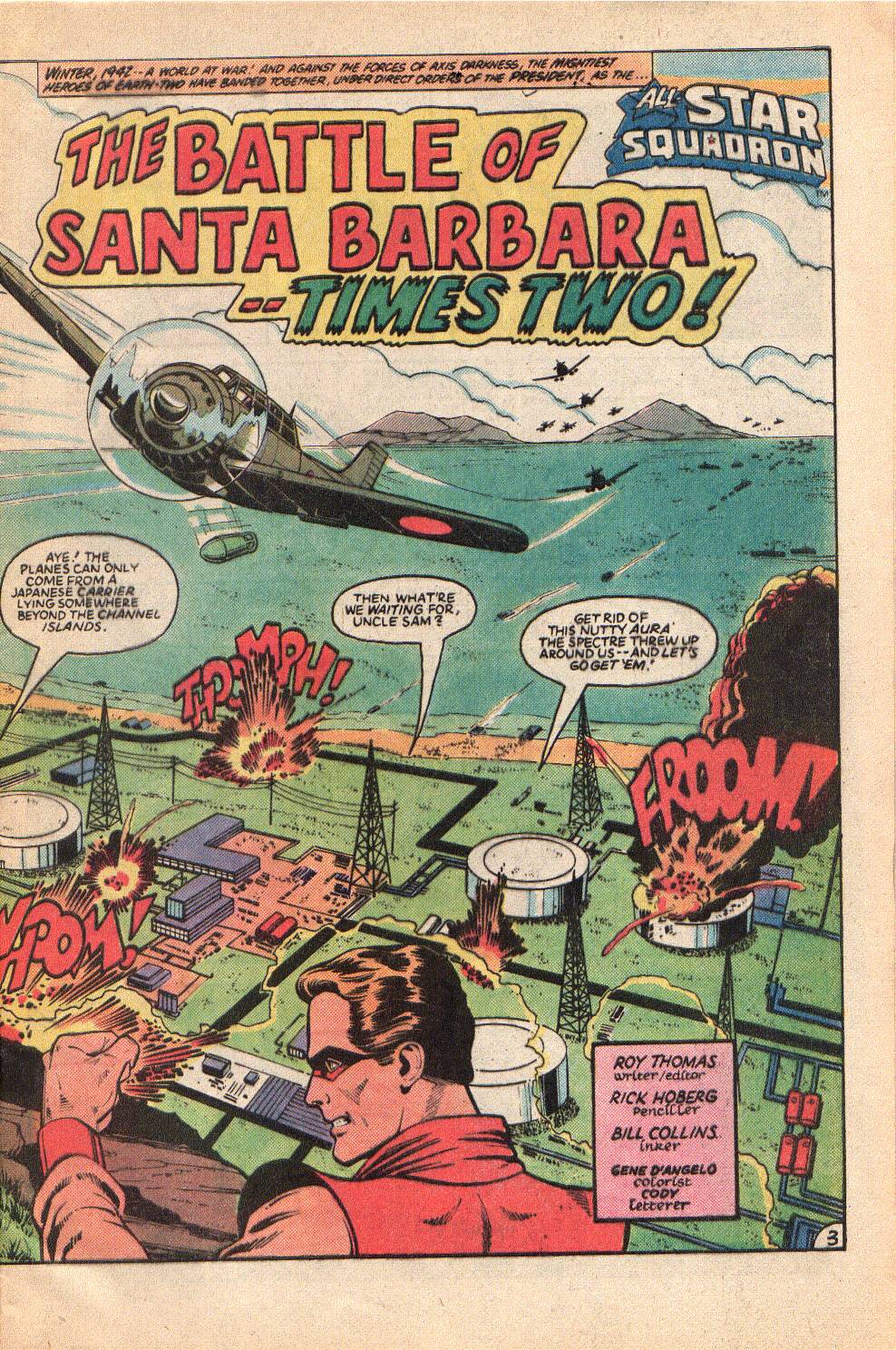 If they hit the snooty yacht club, I don't mind at all. I had to play toy soldier for them, when I was a midshipman (that was 1987, though) The Japanese are attacking the oil refinery and are landing troops, while only receiving token resistance. Uncle Sam leads the charge, while swinging a .30 cal machine gun like a bat.... 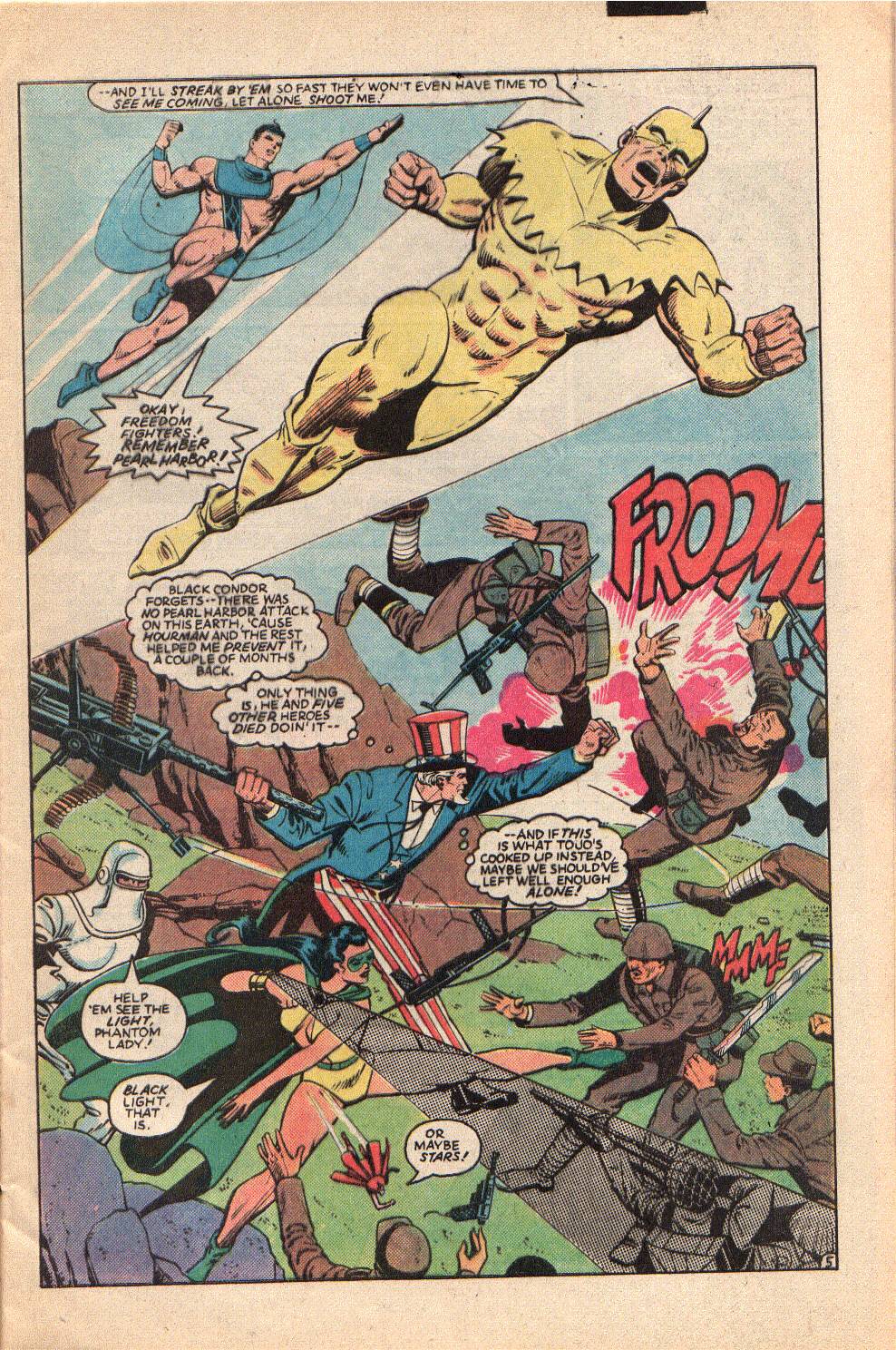 The Ray diverts bombs to the Japanese destroyer below, while Black Condor pulls pilots out of planes and dumps them in mid-air (with time to pop their 'chute). Huma Bomb blows up landing barges, while the rest pound on the troops. Meanwhile, Starman is transporting Johnny Quick, Firebrand and Liberty Belle across country, to meet up with Belle's old beau, Capt. Rick Cannon, of G-2 (Amy Intelligence and yes, I know that's an oxymoron). Is it Dear Johnny time? The captain is missing. belle goes off with Starman to scout, while Brandy tells off Johnny (after Belle did so, about constantly comparing himself to the Flash) and a chastised Johnny Quick and Firebrand search for the missing Coast Guard cutter, spot a houseboat floating and meet up with one Neptune Perkins... 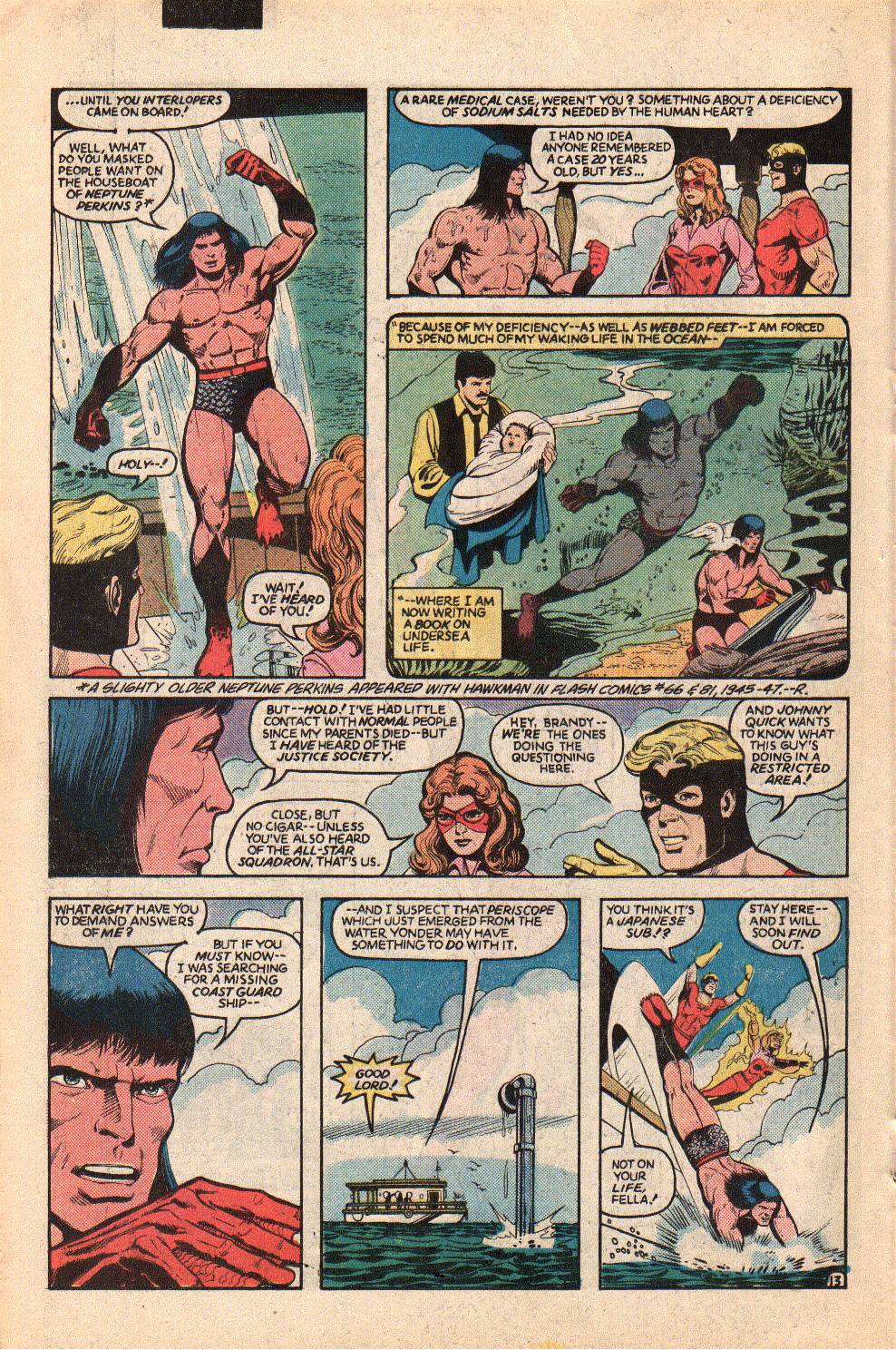 After detailing his past, Perky spots a periscope and dives after, while Johnny and Brandy fly over. Starman and Liberty Belle find a meeting of Japanese, with a mysterious woman, who turns out to be Tsunami, who is nissei and is stirring them up against White Society, which has it coming, to be honest.  The issei and nissei reject her and Cannon gets his gag off and calls for the men to attack her, and gets a demonstration of why she wears a costume and has a fancy name. Belle flips, touches her belt buckle, which signals that the Liberty Bell should be rung and she grows more powerful. She and Starman leap into battle. Starman intercepts Rick and Belle has a catfight with Tsunami and has to hop away. Tsunami uses a water pipe to drench Belle and Starman and knock away his gravity rod. Tsumai lifts large crate to throw at them but hits an old man who leaps to their defense and she is horrified and flees. The dying man tells Belle that Tsunami is his daughter. Starman pursues her. Spectre is still trying to interfere and is blocked. The Freedom Fighters take the fight to the fleet and are kicking butt, when Baron Blitzkrieg turns up with Hourman chained across the barrel of one of the ship's guns. 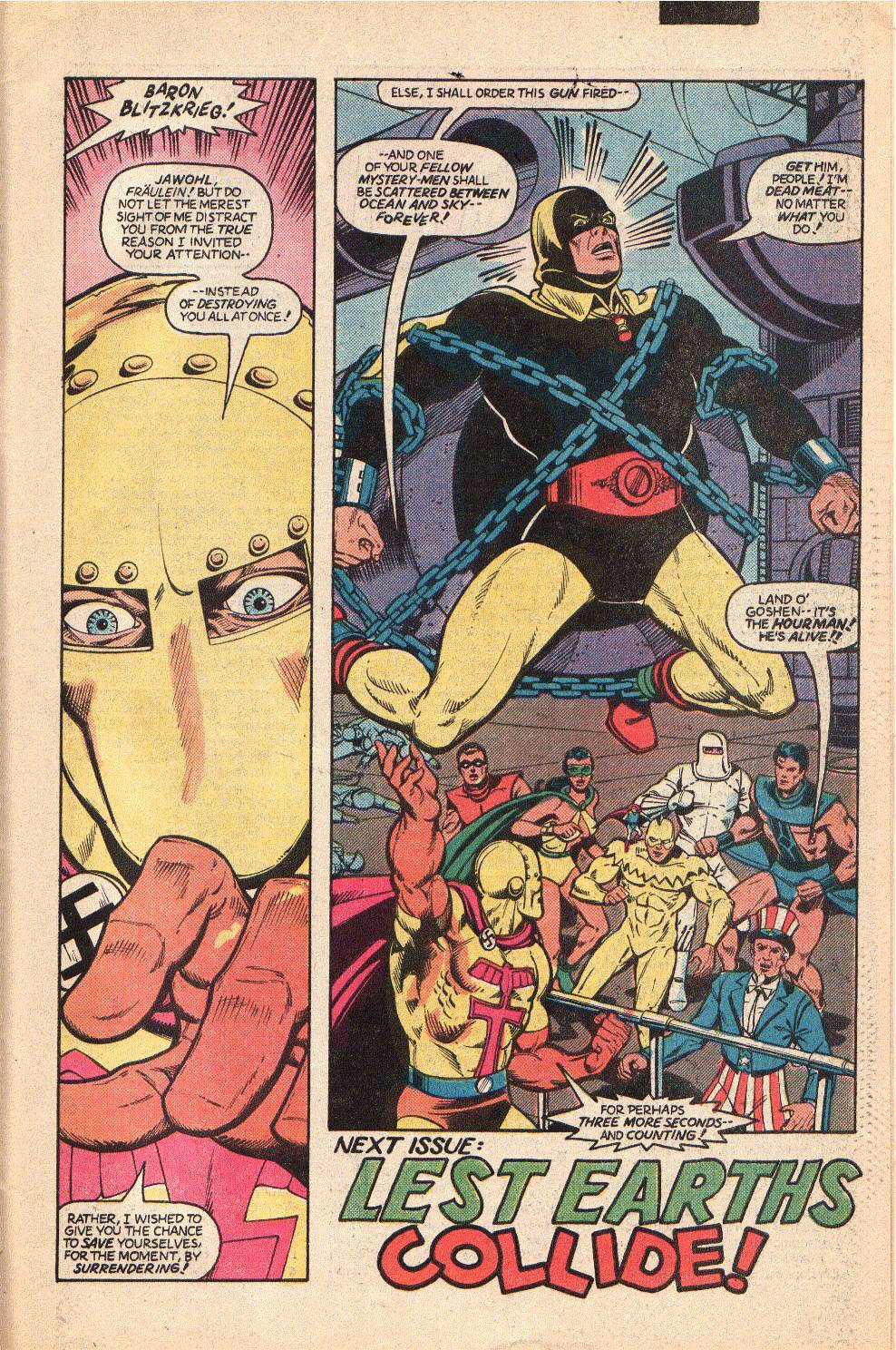 They surrender or Hourman gets an 18 inch shell through his abdomen (which is like having a Volkswagen Beetle fired through you!) Thoughts: Freedom Fighters get to strut their stuff, while Johnny and Libby carry the soap opera and we meet Neptune Perkins and Tsunami, who will be regular cast members of the Young All-Stars. Tsunami is a new character; but, Neptune Perkins first appeared in Flash Comics #66, in 1945. An editorial note tells us that the older Perky will meet the Flash, then. Tsunami is used to set up the Japanese immigrants and children of immigrants (issei and nissei) to reject Tsunami and Imperial Japan, to demonstrate, via hindsight, that most Japanese were loyal to the US, despite being denied citizenship and treated like criminals, without due process of law. One of the group mentions he would join the Marines, if they'd let him. They soon would, which I will cover in the Historical Notes. Baron Blitzkrieg appears again and Hourman is still alive (like Roy was gonna kill off someone who appeared alive in the modern era). Rick Cannon apepared in Liberty Belle's origin story and was going to get a superhero name , Captain Cannon and become a doc Savage type, but Roy never got around to it. I suspect he was going to end up Cannon Fodder. While we are on the subject, any bets on who is going to die by end of this storyline? Historical Notes: At the time of Pearl Harbor, the 298th and 299th Hawaiian National Guard contained large numbers of soldiers of Japanese birth or nissei. They helped prepare for invasion, donated blood, cleared rubble and other duties assigned to them. It didn't matter. Three days later, they were stripped of their rifles. Members of the ROTC, who were part of the Hawaiian Territorial Guard, were discharged, after helping to guard instalaltions. They petitioned to form an all-volunteer civilian enginerring group, to act as labor and the request was granted, creating the Varsity Victory Volunteers. The unit provided labor gangs for construction projects and were quartered, separately, at Schofield Barracks. Their hard work and enthusiasm won over other units and they were soon involved in interracial parties and work, helping to set a path for those who would follow. Meanwhile, 1400, during the Battle of Midway, were stripped of arms, boarded on a ship and sailed to Oakland, without being allowed to say goodbye to family. They were redesignated as the 100th Battalion and sent to Camp McCoy, in Wisconsin. Their officers were trained in psychology and were told to test their loyalty. the men proved highly motivated and excelled in physical challenges and proved to be Loyal Americans. They successfulyl completed combat training and were included in the forces for the Operation Torch landings and would then go on to fight in Italy, participating in the liberation of Rome. The VVV and 100th battalion then paved the way for what would become the most decorated combat unit in US Army history: The 442nd Regimental Combat Team. Initially, the Nissei were denied the right to serve, until the War Department called for all the volunteers it could get. A committee was set up to study the issue of the nissei serving and recommended against it; but, the War Department argued differentl;y and Pres. Roosevelt sided with the War Department, signing an Executive Order that allowed their service. The 442nd was formed with largely Hawaiian nissie, though a contingent from the Continental US would join them. There were rivalries between the two groups. The Hawaiians referred to mainlanders as kotonks, the sound of them hitting their heads on the ground, like coconuts. The mainlanders called the Hawaiians Buddhaheads, or Butaheads, as buta is Japanese for pig. Soon, they learned to work together and their unit motto was "Go For Broke." They did more than live up to it, as the 442nd, which was put together with the 100th, became known as the Purple Heart Battalion, due to their high casualty rate in Italy. They were in the thick of fightingand they fought harder than anyone, because they had something to prove. Their legend would be forever etched in stone in the Vosges Mountains, as they rescued the Lost battalion. The 141st Regiment (Alamo), a regiment of Texans, was cut off and encircled by the Germans and were getting slaughtered. The 442nd was ordered to rescue them. They moved through fog, darkness, snow, damp cold and thick forest to get to the cut off group. They saw the heaveiest fighting of the war. They were stalled, when two groups were able to see each other rise as one, to charge and others rose as well and launched a banzai charge against the Germans, firing from the hip, throwing grenades, and fighting hand-to-hand with rifle and bayonet, until the German grenadiers broke and the nissei stormed through. They lost 800 men, but reached the Alamo Regiment and kept going, fighting between October 26 and November 17, 1944, before they were relived, pushing the Germans back to the Saint-Die. The unit won 8 Presidential Unit Citations, and over 18,000 awards for bravery in two years, including 21 Medals of Honor, 52 Distinguished Service Crosses, 1 Distinguished Service Medal, 560 Silver Stars, 22 Legion of Merit, 15 Soldiers Medals, 4,000 Bronze Stars, and 9, 486 Purple Hearts. This for a group that never numbered more than 4,000 men. Of the 21 Medals of Honor, only 2 were issued during the war, as the others had been given lower honors. A commission in 2,000 upgraded the award for the remaining 19, grant recognition of their heroism that was denied them due to racism. One of those Medal of Honor winners was Lt. Dan Inouy, who led an assault on a heavily defended ridge on wat was known as the Gothic Line, in Italy. His men came under fire from 3 machine gun positions. Despite the hail of gunfire, Inouye rose to his feet and sustained wounds to his stomach, but ignored them and destroyed a machine gun position with hang grenades and his Thompson SMG. He then refused treatment of his wound and directed the assault on the second machine gun position, before collapsing. His men occupied the third position, while he crawled towards the bunker and raise up to throw a grenade he was hit by a rifle grenade, which didn't explode but tore off much of his right arm. His men moved to help him but he ordered them to stay. He picked up his grenade in his left hand and threw it into the slit, killing the grenadier. He then killed another with his SMG. a 5th wound, to the leg, halted his advance and rendered him unconscious. When he awoke to find his men hovering over him and worried about his condition. he ordered them back to their positions, saying, "Nobody called off the war!" The remainder of his right arm was amputated at a field hospital. He was originally awarded the DSC, but the later rightfully upgraded it to the Medal of Honor. Inouye had planned on becoming a surgeon, but the loss of his arm prevented that. While recuperating, he met Bob Dole, who had also had an arm injured, and Philip Hart, who was injured on D-Day. They became lifelong friends and Dole expressed a desire to become a congressman. After his discharge, Inouye studied political science, under the GI Bill, at the Univ of Hawaii. After serving in the Hawaiian territorial House of representatives, he became Hawaii's first Representative in the US House, after Hawaii achieved statehood. In 1962, he was elected to the US Senate and continued to serve there until his death, in 2012. he was notable for attacking the secret operations of the Reagan Administration, during the Iran-Contra Hearings and lambasted Col. Oliver North. He appeared in the movie, The Next Karate Kid, in an opening scene of the surviving members of the 442 Regimental Combat Team being honored in Washington, DC, with the fictional Mr Miyagi present, as his backstory made him a member of the unit and one of the Medal of Honor winners.   May, 1942 The war went poorly for the Russians. The 5 month battle for the Kerch peninsula, in the Crimea ended in German victory. The Russians lost over a half a million men in the fighting. The Germans would soon launch an offensive to seize the Caucus Oil Fields. The Russians also launched an offensive to seize the Ukrainian city of Kharkov from the Germans which would end with the Russian forces encircled and destroyed. Russian military leadership was still suffering from Stalin's purges of the senior ranks. It would take new, younger, more dynamic leadership and Soviet industrial production to start turning the tide. The Japanese were also doing well, with a midget submarine attack on Sydney Harbor, in Australia. 2 of the 3 subs were detected and attacked before they could launch their own attack. The M-14 was scuttled by its two-man crew, while M-21 was sunk by the defending forces. M-24 launched an attack on the USS Chicago; but, only managed to sink the converted ferry HMAS Kuttabul. The submarine that launched the mini-subs carried out maritime attacks in Australian waters, sinking 3 ships and bombarded Sydney and Newcastle, during their operations. The Japanese also launched the invasion of Tulagi, in the Solomon Islands. The intent was to establish a base to protect their flank and disrupt se lanes between Australia and New Zealand, as well as divert attention from the Japanese invasion force that was headed for Port Moresby, in New Guinea. The islands were evacuated due to the inability to defend the islands, but, the landing forces came under attack from aircraft from the USS Yorktown, which succeeded in damaging a few ships, but was unable to halt the invasion. The Yorktown would continue towards its rendezvous with the USS Lexington Task Force, which was about to have its own fight. US forces on Corregidor surrendered to the Japanese, effectively ending the fighting in the Philippines. However, pockets of guerrilla warfare would continue up through the Us Invasion at Leyte Gulf, in 1944. Mexico joined the war, on the Allies side, after the sinking of the Faja de Oro, by a German U-Boat. The Japanese helped with the security of the Panama Canal, as well as providing material supplies to the Allies, as well as providing air forces, Escuadron 201, which took part in air operations at Luzon, in the Philippines and at Formosa. On May 8/9, gunners of the Ceylon Garrison Artillery launched a mutiny, which was put down and 3 soldiers were executed. The first group of African-Americans were taken into the US Navy for service as seamen. In Libya, Free French Forces fought off attacks by the Afrika Corps, during their advance on Tobruk, at the oasis Bir Hakeim. They fought from May 26 to June 11. The Germans eventually succeeded in capturing Tobruk, but called off Operation Herkules, which would have launched the invasion of Malta. Even Hitler praised the French forces. May 30/31 saw the first "1,000 plane" raid by British Bomber Command, on the city of Cologne. Bomber Commands accuracy failures in 1941 led many to demand an end to their strategic bombing campaigns so that the aircraft could be freed up to provide air support for ground operations. Air Marshal Arthur "Bomber" Harris ("Butcher," to some) wanted to prove Bomber Command could make a significant contribution to the war. Initial target of the raid was to be Hamburg, but weather prevented it and Cologne was chosen. The choice was somewhat dictated by the city being within GEE range. GEE was a navigational system that allowed a receiver to plot position, based on two converging radio signals. This allowed for far greater navigational accuracy to the target. The aircraft were loaded with 2/3 of their supplies as incendiary bombs. The raid resulted in over 1700 separate large fires and only the actions of the firefighters prevented a firestorm from consuming the city. Most of the damage was to civilian housing areas The use of incendiaries was also, in part, revenge for fires that erupted during the bombing of London, during the Blitz. The British launched the Invasion of Madagascar, attacking the Vichy French forces there, seizing the port of Diego-Suarez. The goal was to deny the facilities to the Japanese and protect Allied shipping into the Indian Ocean. The landings succeeded and further landings in September helped defeat the French and the entire island was in the hands of the Allies by the end of October. Now, the main event. The Japanese launched a two-pronged offensive, designed to increase their area of control and threaten lines of communication to Australia. The Japanese Army launched an operation to land at Port Moresby, in New Guinea, while the Japanese Navy launched Operation Mo, to seize Tulagi, in the Solomons. US Navy signals intelligence intercepted radio traffic alerting them to the plans and sent two carrier task forces to Australian waters to intercept the Japanese. As discussed, Adm Frank Fletcher's group launched air attacks on the Japanese at Tulagi, but could not inflict enough damage to halt the operations and continued to steam for their rendezvous with the USS Lexington Task Force, which was headed to face the Port Moresby invasion fleet, in the Coral Sea. 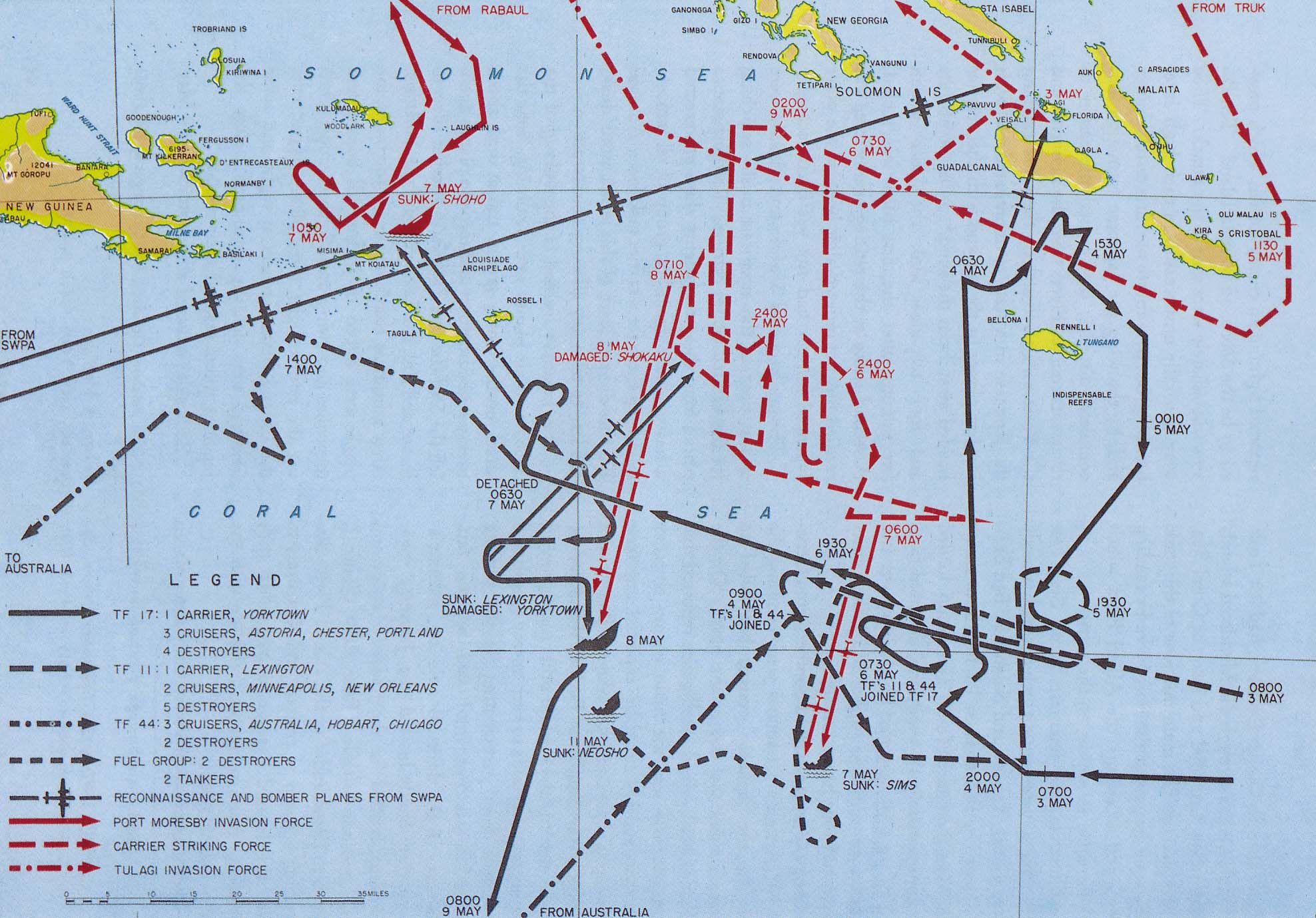 Signals intelligence gave Port Moresby as the main invasion target and the likelihood that the Japanese carriers would be concentrated there. The Navy hoped to inflict damage on Japanese naval air forces, which would severely limit their ability to conduct further offensive operations beyond land-based aircraft range. This would buy time for the Allies to build their forces and re-engage the Japanese and push them back from occupied territories. Admiral Nimitz, acting on intelligence assessments of the Japanese Operation MO, dispatched 3 carrier task forces to link and intercept. This included Task Force 17, under Rear Adm. Frank Fletcher, on the USS Yorktown, Task Force 11, under Rear Adm Aubrey Fitch, on the USS Lexington, and Task Force 16, under Vice Adm. William "Bull" Halsey, with the USS Enterprise and USS Hornet. Halsey as returning from the Doolittle Raid, but would not be in position in time, so Fletcher was placed in command. He had reconnaissance aircraft searching for the Japanese forces, which included the aircraft carriers Shoho, Zuikaku and Shokaku. The Shoho supported the landings at Tulagi and the japanese began construction on a seaplane base. Fletcher launched attacks on the Japanese the following morning and sank a destroyer, three minesweepers and damaged 4 other ships, before withdrawing. Both sides had aircraft searching for the other and Wildcats intercepted a Japanese seaplane and shot it down. The Japanese later spotted the task force and dispatched ships to search for it, as worsening weather prevented further aerial spottings. The next morning, Japanese scouts spotted the oiler Neosho and the destroyer Sims and mistakenly radioed identification as a carrier and light cruiser. The Shokaku and Zuikaku launched aircraft. After searching in vain for the US carriers, Adm Takagi redirected his forces, after scouts located the Yorktown between him and the invasion convoy, putting them in great danger. The US launched aircraft to attack the main fleet after the Shoho and its escorts were mis-coded as the main fleet by a scout aircraft. When the pilot returned to the carrier to refuel, he discovered his coding error and the aircraft were diverted. Aircraft from the USS Lexington launched the first wave of attacks on the Shoho and heavily damaged it, and a second wave from the Yorktown sank it. Aircraft were recovered and refueled and Rearmed, while the search continued for the main invasion fleet. Fletcher kept his fighters armed and ready, while they hid under overcast skies. The Japanese learned of the loss of the Shoho and ordered the invasion fleet to turn back to the north, while Takagi was ordered to locate and sink the American carriers. Earlier, a detachment was sent to the Louisiades to close the gap between islands, blocking the invasion fleet. Scout aircraft from Rabaul spotted the detachment and erroneously identified it as the carrier group. Strike planes were launched and detected by Yorktown, who sent combat air patrol Wildcats after it, which shot down 7 torpedo bombers and a dive bomber, causing strike leaders to call off the attack. They jettisoned their bombs and returned to their carriers. The Yorktown prepared for a complete search at first light. In the morning, both sides launched aircraft to search for the other and both succeeded in spotting carrier. The Yorktown aircraft spotted the Shokaku and launched attacks, succeeding in damaging the flight deck and hangar deck below. The Lexington squadrons succeeded in inflicting further damage and attacked the Zuikaku, but failed to make any significant damage. Shokaku withdrew from actions. Meanwhile, The Japanese sighted the Lexington and launched an attack and badly damaged her. Damage control parties fought to contain the damage and save the ship. Attacks on the Yorktown managed to damage the flight deck and storage below. The Lexington had their ship stabilized, when sparks from a generator ignited fuel and a fire and explosion erupted. The crew abandoned ship and survivors were rescued by the destroyers and then torpedoes were fired into the Lexington, sinking her. The Yorktown was withdrawn and ordered to steam for Pearl Harbor. The Shokaku returned to Japan, nearly capsizing in a storm. The Zuikaku failed to located the withdrawn Yorktown and the invasion ships were rerouted. Halsey's grouped reached the area, but received new orders from Adm Nimitz. Intelligence intercepts had revealed the Japanese plan to attack Midway and Nimitz intended to intercept the carrier group and draw them into a decisive battle that would end their offensive operations for some time. Halsey was order to ensure Japanese scout planes spotted his ships, then withdraw to Pearl Harbor, to combine forces for operations near Midway. Halsey was spotted and the Japanese aborted the intended landings at Port Moresby. The Battle of the Coral Sea was labeled a tactical victory on both sides, though the weight of history put the advantage in the Allies' column. The Japanese had succeeded in sinking one carrier and damaging a second, with the loss of one carrier. The US was not in a position to trade carriers, as of the total of 4 they had, only 2 were fully operational, with the Japanese now threatening Midway Island, which, if taken, put them in striking range of Hawaii, and, from there the West Coast of the United States. However, from the US side, they had succeeded in destroying one carrier and caused the withdraul of another due to heavy battle damage, putting it out of the war for the foreseeable future. The Zuikaku lost aircraft and was pulled to be rearmed. Thus, the offensive capabilities of the Japanese navy lay with the forces preparing to strike Midway. The US was now in a position to ambush and destroy the main Japanese carrier force, a blow from which it could not recover. If successful, the US would end any further threat to Hawaii and the continental US, end the ability of the Japanese to launch any further expansion beyond the range of their existing bases, and the US could then turn its attention towards establishing its own bases from which to launch their offensive to push the Japanese back int he South Pacific. The stage was now set for what would prove to be the turning point in the War in the Pacific.
|
|
|
|
Post by codystarbuck on Aug 9, 2020 19:42:32 GMT -5
ps One other historical note. On May 27, 1943, Czech paratroops were dropped into Czechoslovakia to launch Operation Anthropoid, an attempt to deliberately assassinate SS Obergruppenfuhrer Reinhard Heydrich, the man in charge of implementing Hitler's "Final Solution." The Czechs were trained by the British SOE and armed with pistols, Sten SMGs and bombs. Upon learning of the plans, Czech resistance groups called on the government-in-exile to call off the operation, due to feared reprisals. The mission moved forward and the paratropps attempted to ambush Heydrich on the road, during his commute. A soldiers Sten gun jammed, but he succeed in getting a bomb near the car's wheel. Rather than driving on, Heydrich ordered his car stopped to engage the attackers with his pistol. A modified anti-tank grenade was thrown but it went off under the car's upholstery. However, Heydrich was wounded, including damage to his diaphragm, lung and spleen. He collapsed, but was brought to a hospital and Czech doctors succeeded in stabilizing him and reinflating a lung. Himmler sent SS doctors to care for him and recovery looked good; but he went into shock and slipped into a coma and died. Theories range from an unknown infection, possibly caused by horsehair particles in the upholstery, or an embolism. Theories of poisonings have largely been discredited. Reprisals were swift. Hitler originally wanted to execute 10,000 Czechs, but backed off because of the importance of Czech industry in the German war machine. Arrests and executions followed and it is believed some 5,000 were killed in reprisals. The Allies agreed that the Sudetenland would be returned to Czechoslovakia, when the Germans were defeated and Churchill proposed attacks on the Nazis, for every Czech village harmed. However, cooler heads prevailed. Further assassinations were accomplished in Poland and Belorussia, by partisans. The Czechs had often complained about the quality of British weapons, in training and their fears proved founded, as the Sten SMG failed the attackers. Czechoslovakia was noted in the pre-war and Communist era for its high quality armaments, with their weapons and ammunition being the best of the Warsaw Pact nations, after the war. During the war, Czech factories were used to produce arms for the Wehrmacht. The Sten was a compromise weapon employed by the SOE and special forces of the British army. It was lightweight and could easily be broken down into three main components (the barrel section can be unscrewed, while a button at the back end of the main receiver allows the skeletal stock to be detached), which made it ideal for dropping into occupied territories, for resistance fighters (resulting many falling into German hands) and a fairly effective noise suppressor was developed for it. It was inexpensive to produce and lighter weight than the American Thompson, which the commandos favored for its heavy punch, with its .45 cal ACP round. The Sten went through 6 variations, by war's end, with the final featuring a foregrip, for greater control.  After the war, it was replaced by the more robust Sterling, which had a similar layout, but higher quality manufacture. Stens would continue to be seen in the hands of former colonies and in wars in Africa and elsewhere, as well as in the hands of the IRA. |
|
|
|
Post by dbutler69 on Aug 10, 2020 8:36:49 GMT -5
Rick Cannon was going to be a Doc Savage type character? That's very interesting. Seems like quite a retcon of the character, though.
|
|
|
|
Post by mikelmidnight on Aug 10, 2020 11:38:02 GMT -5
Rick Cannon was going to be a Doc Savage type character? That's very interesting. Seems like quite a retcon of the character, though.
What would have been the point? We need another heroic white guy with generic athleticism? As I said earlier, he ought to have nabbed Jim Anthony.
|
|
|
|
Post by codystarbuck on Aug 10, 2020 12:04:12 GMT -5
That's according to the All-Star Companion. Probably why he never got around to it; it really served no purpose. Mostly, he is just a fly in the ointment for Libby and Johnny's romance.
|
|
|
|
Post by codystarbuck on Aug 14, 2020 17:30:51 GMT -5
All-Star Squadron #34 I can think of only one thing to compliment that cover... Creative Team: Roy Thomas-writer/editor, Rick Hoberg-pencils, Bill Collins-inks, Cody Weiss-letters, Gene D'Angelo-colors. Synopsis: Johnny Quick, Firebrand and Neptune Perkins are searching for the submarine that belongs to the periscope they spotted last issue. Neptune's younger brother Jack stays on shore, practicing his introductions. Johnny is making an ass of himself since Libby told him off. He pretty much implies that Neptune is a Nazi agent. Firebrand calls him out on it. He starts to tell her to go find Starman & Liberty Belle and she tels him to do it himself; she's not his errand girl! 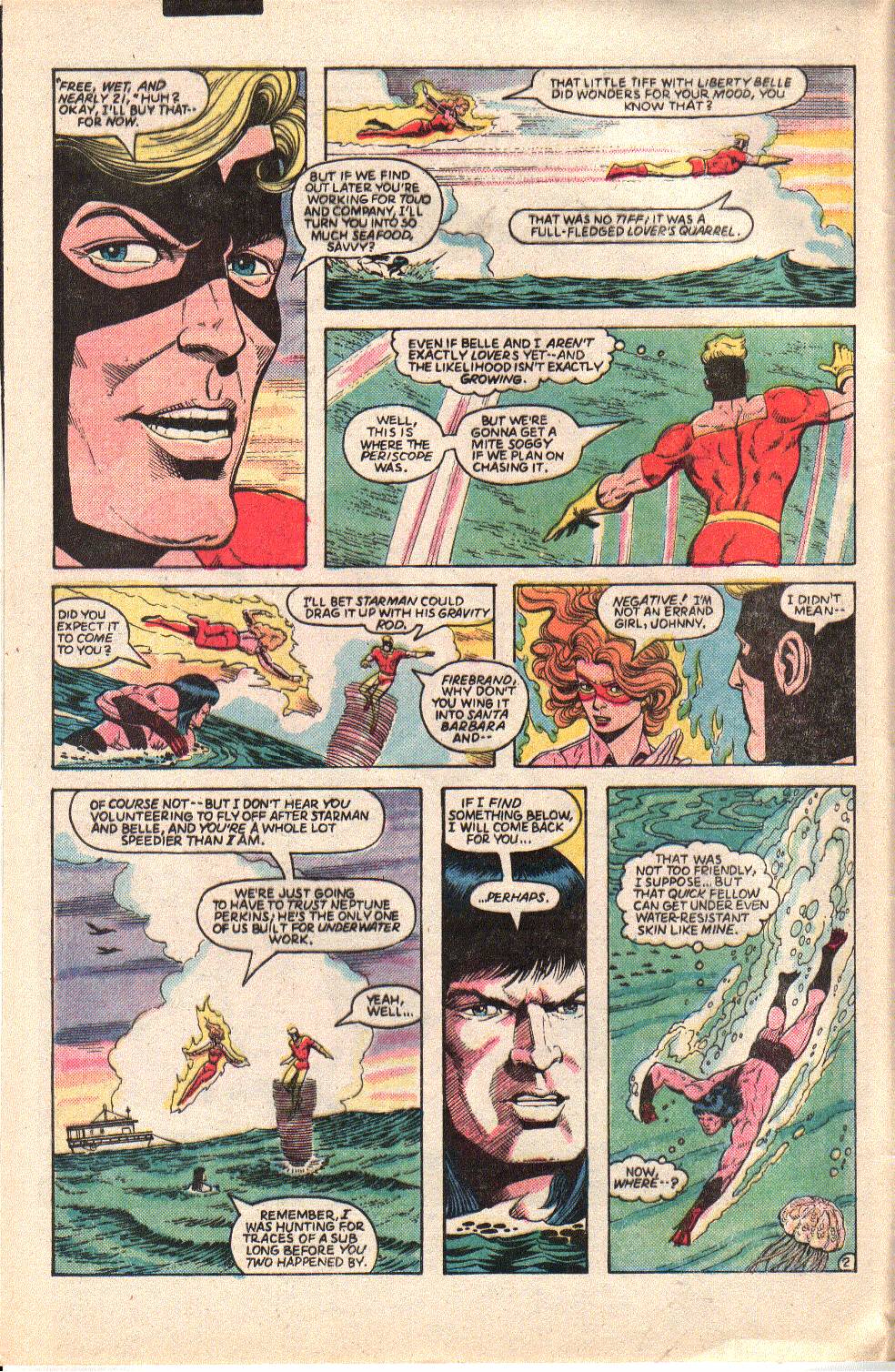 You go girl! Neptune finally spots the sub and decides to try to foul its screws. Johnny gets antsy, since Neptune hasn't come back and dive into the water. He decides he can disable the sub all by himself and gets trapped in a net. Perkins goes to rescue him and they get zapped by the electrified net. Brandy dives into the water to see what is going on; but, can see nothing and surfaces, swimming to Perkins' anchored houseboat. Johnny and Neptune are pulled onto the submarine and are introduced to Captain Kozo Nishino, who has targeted Santa Barabara's oil storage tanks because he was once humiliated there... 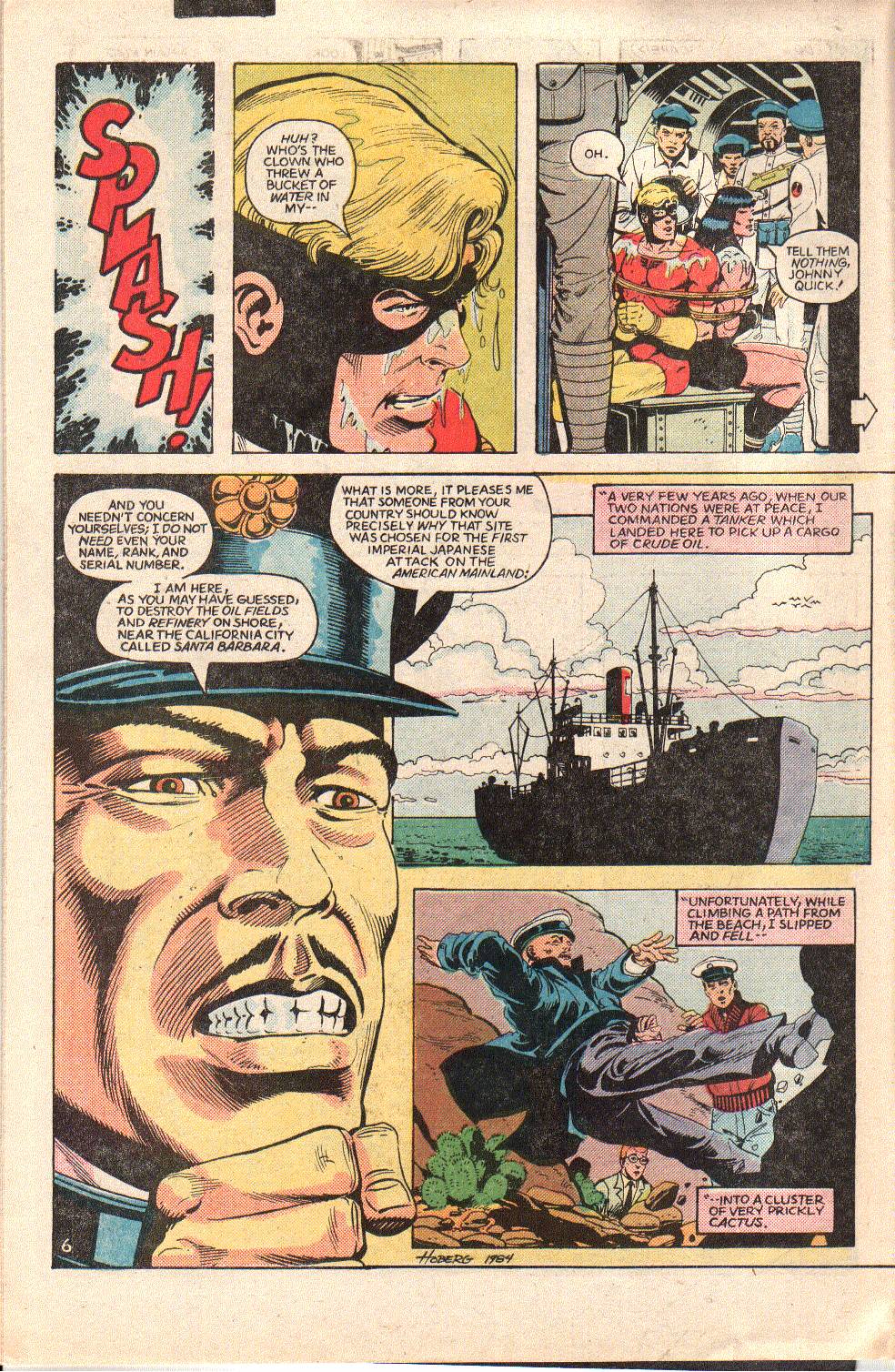  Meanwhile, the Spectre is busy trying to keep the two parallel Earths from coming together and occupying the same space. Didn't he do that once before, with Earth-1 and 2? Something like, in a JLA/JSA crossover... On Earth-X, Hourman is changed across the muzzle of an 18 inch gun, though Roy says it's on a destroyer. Nope; sorry Roy. I doublechecked last issue; Hoberg drew a battleship, complete with 18 inch guns, not a destroyer. They had smaller guns. He also drew wooden planking, which was used around the forward guns. Anyway, Baron Blitzkrieg says surrender or he gets a shell up the jaxie (been watching Are You Being Served?). 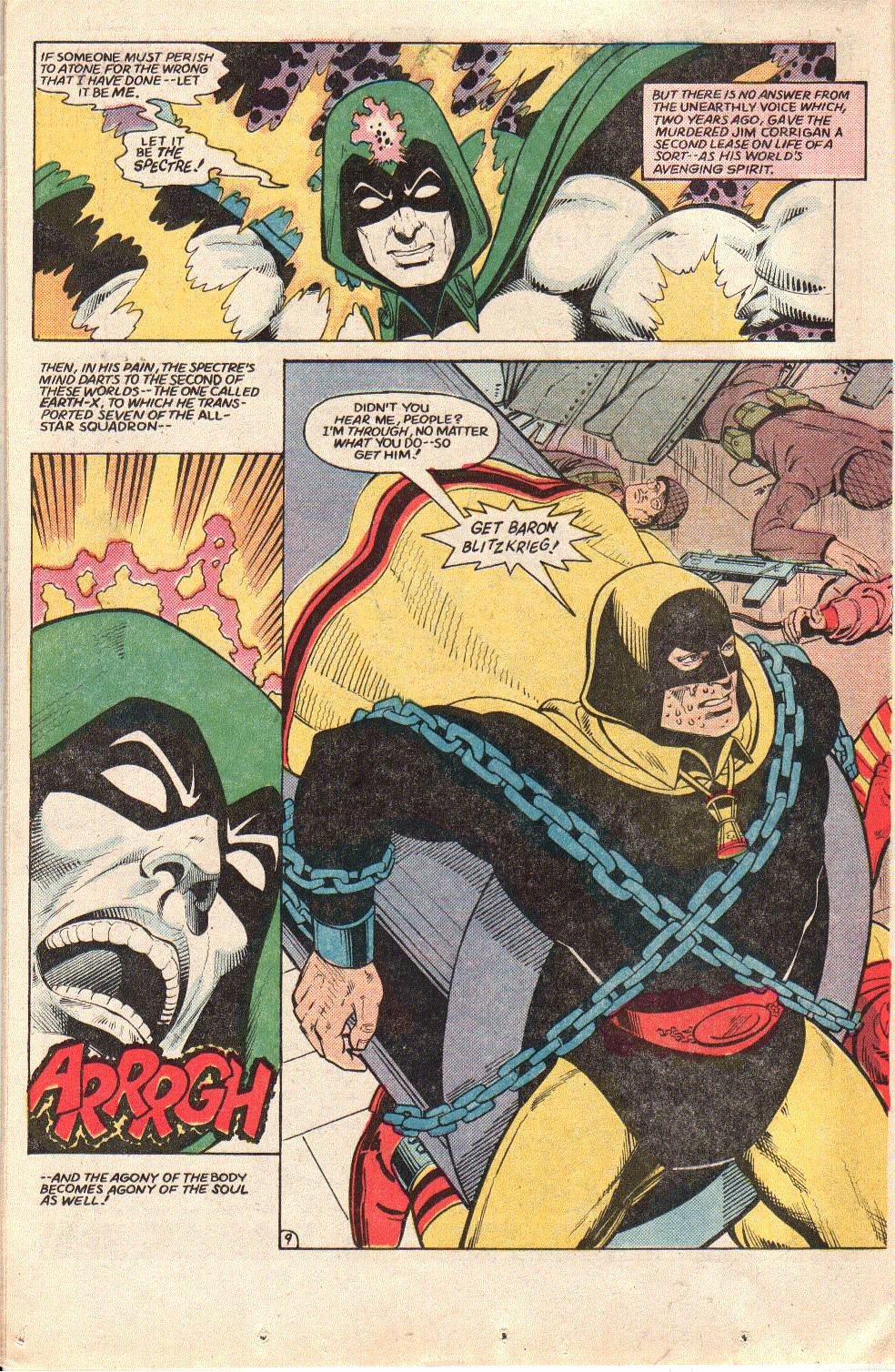 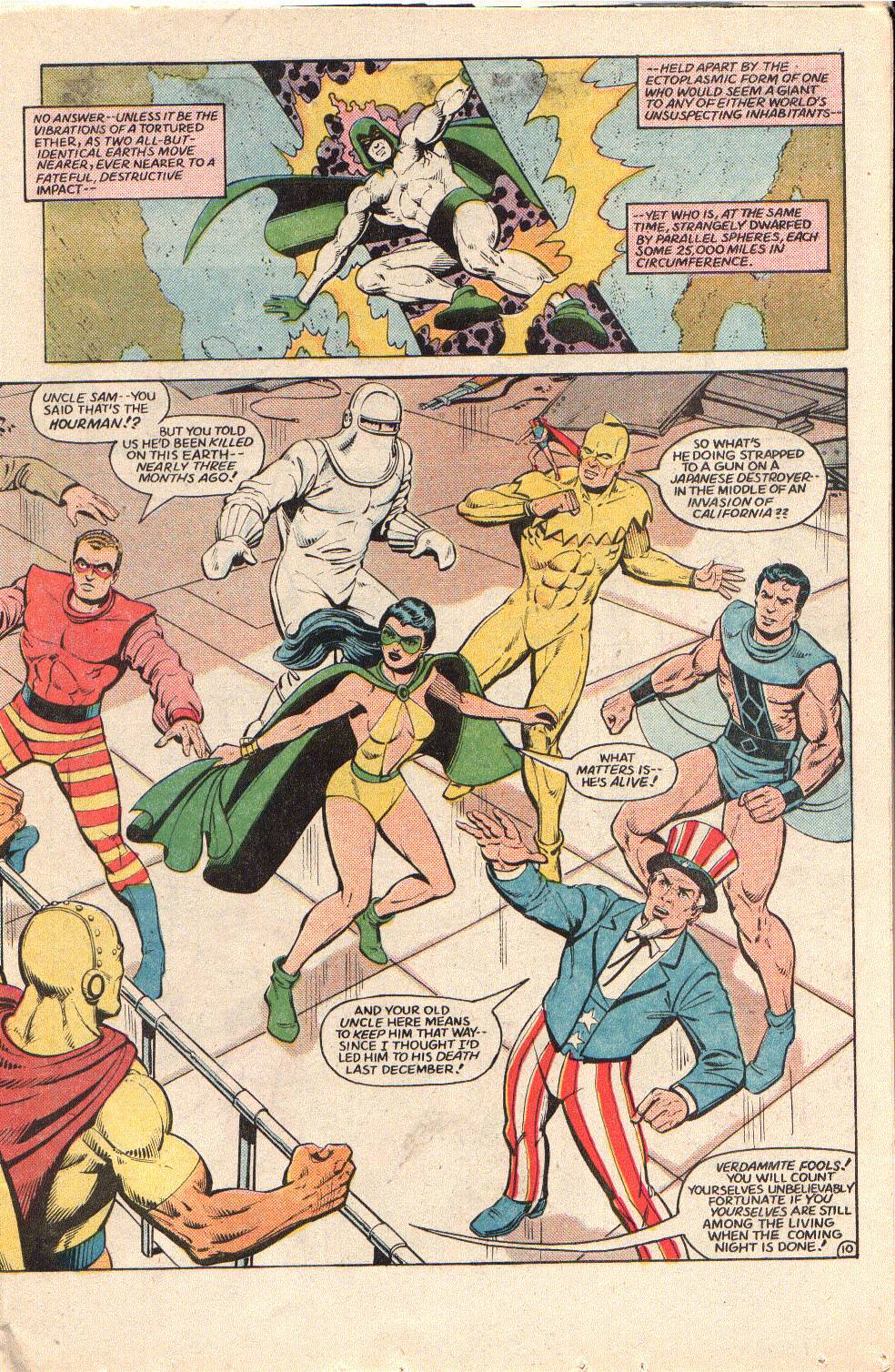 Hourman says get the rat and the Ray takes it into his own hands and pastes the Baron with a knucklewurst sandwich. The rest join in, including the Red Bee, who unleashes his secret weapon......some bees. 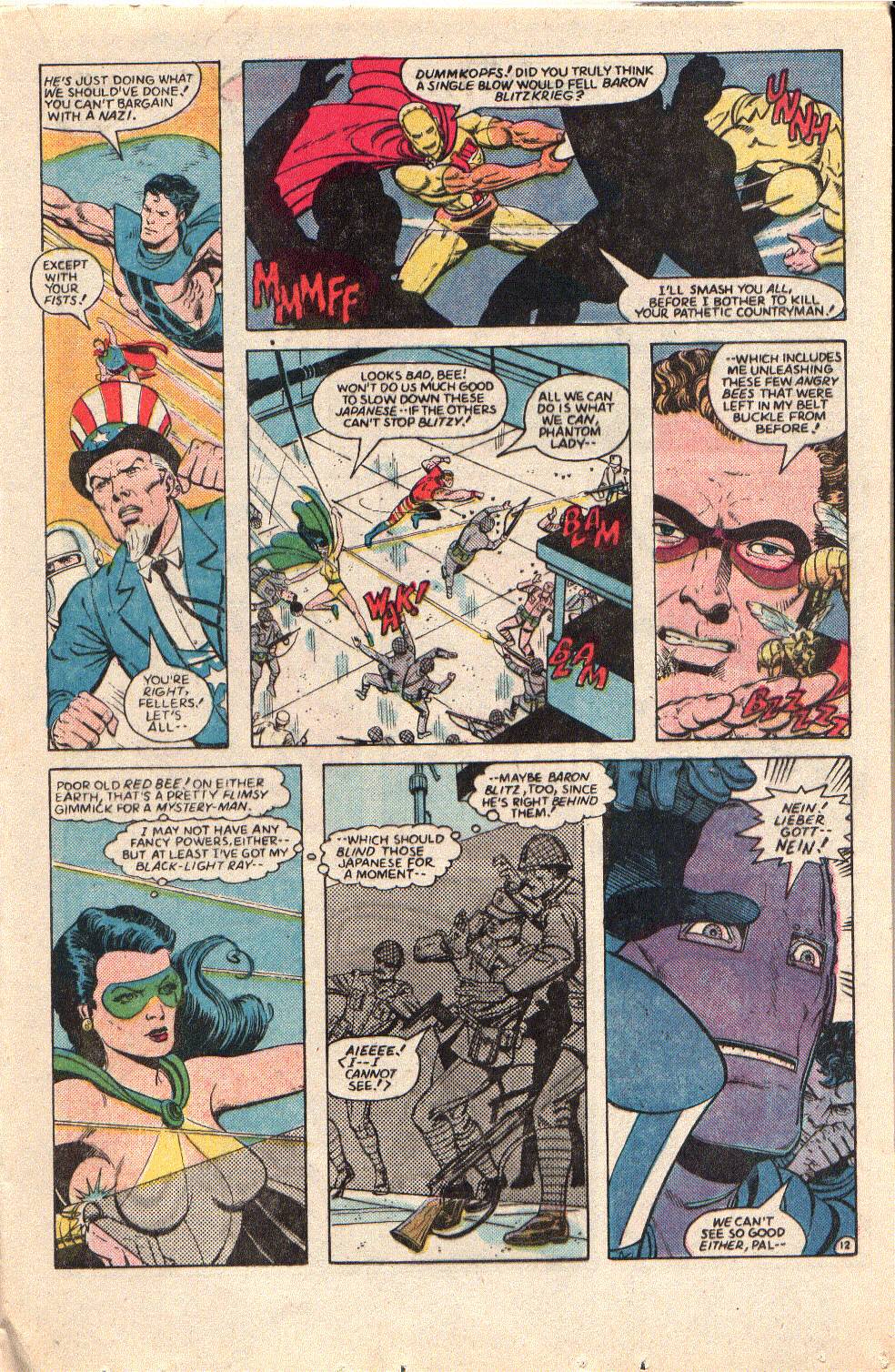 Even Phantom Lady finds this pathetic and blinds the Japanese with her headlights....er, black-light ray. How the heck is she keeping her.....self....covered? There is no cloth around the back! Must have a LOT of tape! Baron Blitzkrieg freaks out when he goes blind and starts flailing around. Human Bomb takes off his glove to give him a TNT goose; but, Blitzy knocks his attackers aside and sends HB tumbling and Uncle Sam lands on his exposed hand and BOOM!!!!!! He then regains his sight and hits Phantom Lady with his Nazi-Vision. Red Bee has disappeared. Probably smelled nectar. BB snaps off Hourman's chains and slaps him around a bit. Meanwhile, the Japanese sub receives a visitor, as Tsunami comes on board. She banters with the captives, while the skipper tells her to belt up and orders the sub to surface. The deck gun is manned and they fire on the refinery. 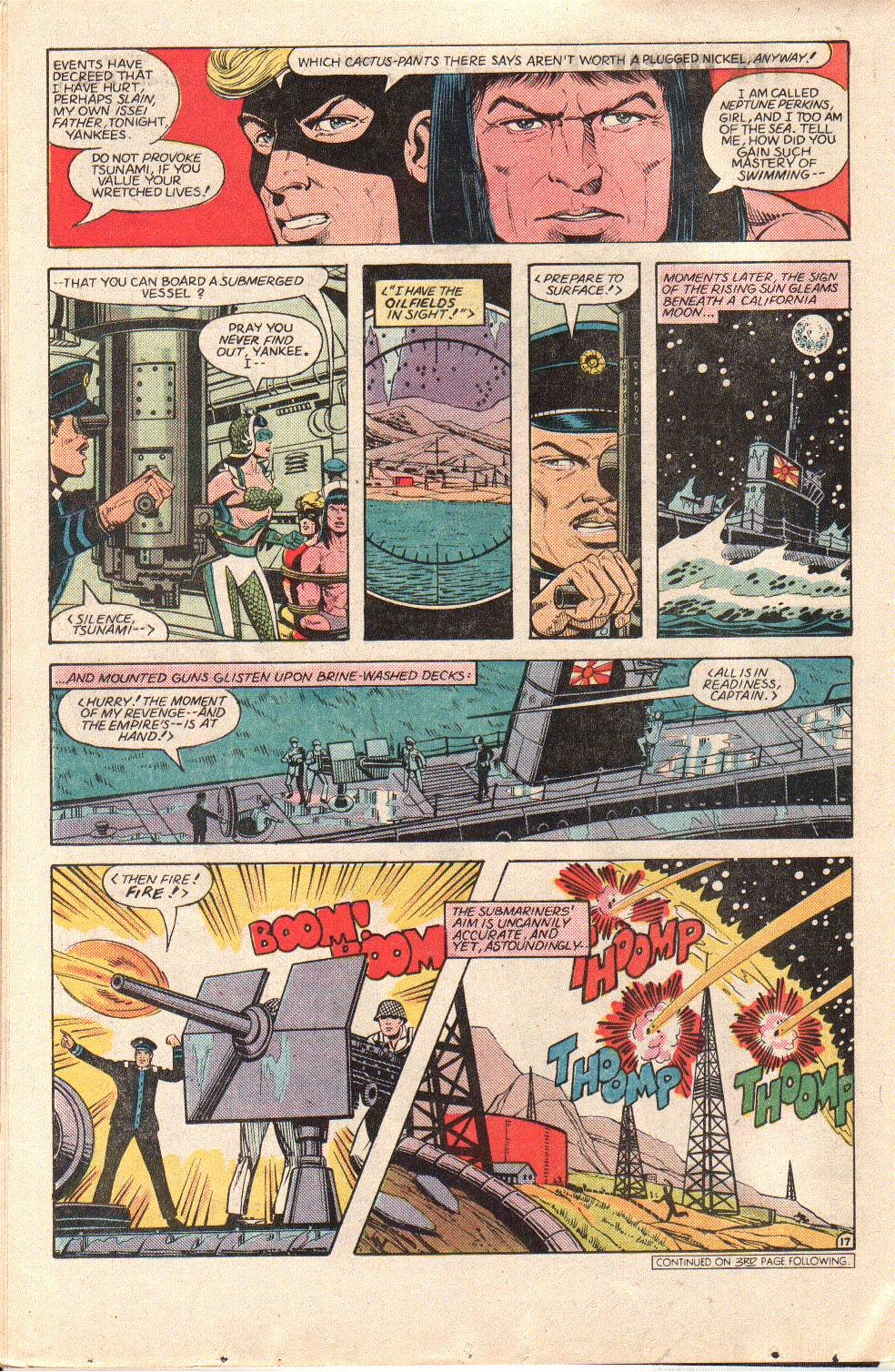 However, an energy shield, generated by Starman's Gravity Rod, blocks the shells from doing harm. Firebrand drops Liberty bell on the deck and they kick some sailor butts. The skipper zips down a hatch and locks it behind and calls for a crash dive and the gals lose him. The skipper orders the prisoners to be killed and Tsunami argues against it, given Perky's powers. The skipper tells the lowly woman to shut he sashimi hole and tells his men to get on with it, when a ray destroys his pistol, which looks more like a Walther p_38 than a Nambu. In walk Starman, Liberty Belle and Firebrand, via a cosmic energy door. They free the bous and Johnny joins the fun. In the fight, a pistol goes off and hits something that blows Libby and Johnny out into the ocean. Johnny is down for the count and Libby drags him to a nearby buoy. Then Tsunami turns up to F them up.  Thoughts: Thoughts: I think Roy is dragging this out a bit too long, though he gives it plenty of action. The sub....er,sub-plot is somewhat based on fact. More in the historical Notes. The Baron Blitzkrieg battle should have been the main feature, in my estimation. Roy still hasn't provided much characterization for the Freedom Fighters, which seems odd, given they are the heart of this story. It seems that he assumes we have all either read the Quality Comics stories, the various reprints by DC (in the 100-pg comics) or the Freedom Fighters comic series, which was set after Earth-X had been liberated by the JLA, JSA and FF. Sales suggest that was a foolish assumption. The sub stuff is interesting, though Johnny is making a massive horse's patoot of himself throughout. While I get he is a main character and one of Roy's favorites, it seems a bit out of proportion. Not sure why Roy showed preference for Neptune Perkins over Aquaman, who was name-dropped a couple of issues before; other than obscurity. Also, no idea if Neptune is related to host Jack Perkins, of the A&E Network, in the 90s. Historical Notes: On February 23, the Japanese sub I-17 surfaced off the California coast, near Elmwood, just outside Santa Barbara. They turned their deckgun towards the Richfield aviation fuel tank and opened fire. They continued firing for approximately 20 minutes, firing somewhere between 12 and 25 rounds (estimates vary). The submarine was commanded by Captain Kozo Nishino, who had commanded a merchant ship, before the war, which had stopped at Elmwood and he was familiar with the area. The actual reason for the attack was to sow fear, as FDR was making a radio broadcast, one of his "fireside chats," detailing the progress of the war. The attack was simply an act of psychological warfare. It was followed the next night by a false alarm which led to the Battle of Los Angeles, where anti-aircraft guns fired at nothing, after the commanding general panicked. The story Roy uses seems fictional, as I haven't found verification of any personal humilation. The attack was ordered by his superiors, though he chose the target, as he was familiar with the area. These two events were the inspiration for the Stephen Spielberg film, 1941. June 1942 Reinhard Heydrich succumbed to his wounds and died. reprisals against the Czech population began. 340 people were killed in the town of Lidice, which was falsely thought to have sheltered the two paratroops who carried out the assassination attempt. the town was destroyed by fire and explosives. The paratroopers, themselves, were cornered in a church, with one killed in the shootout and the other committing suicide, rather than be captured alive. The Germans launched Case Blue, a new offensive aimed at Stalingrad and the Baku Oil Fields. The Russians mistakenly believed it was a feint in conjunction with an attack aimed at Moscow. Initial attacks were successful and the Germans made great headway, but ran into heavier resistance from Russian reserves, deployed ahead of Stalingrad. The offensive stalled into the Siege of Stalingrad, with the Germans occupying 90% of the city, by November. Stalin ordered the city that bore his name to be held at all costs and the Russians suffered over a million dead defending the city, killing anywhere between 600, 000 and 900,000+ Germans, Hungarians and Romanians. Bulgaria, Hungary and Romania were formally allied with Germany and the US declared war on them on June 5. On June 12, in Amsterdam, Anne Frank receives a diary for her birthday and makes her first entry. Her record of hiding from the Germans, as well as life with her family, would survive her death, probably from typhus, at Bergen-Belsn, in 1945. The family was discovered in 1944 and arrested and Anne was sent first to Aushwitz, then Bergen-Belsen. Her father, Otto, survived the war. Miep Gies and Bep Voskuijil, who helped hide the Franks, found the loose pages in the hiding place and hid them away. They returned them to Otto, after the war and he came to know a young woman who seemed so different from the little girl he knew. The diary was published in the Netherlands, in 1947 and translated into editions around the world, in over 60 languages, becoming a noted work of both the Holocaust, and the coming of age of a young woman. Generations have been touched by the words and feelings of Anne Frank, helping her spirit to live on well beyond her body. The Japanese success in the Philippines, Malaysia, Singapore, and the Dutch east Indies had secured their initial goals and led to a pause in their operations. Planning for the next phase was still formulating, when B-25 Mitchell Bombers, under the command of Lt Col James Doolittle launched from the USS Hornet and struck targets on the Japanese Home Islands. The raid did little strategic damage, but, did hammer home the danger of the US carrier fleet. The Japanese had competing plans for continuing the war and eliminating US forces as a threat. The Imperial Japanese Army favored a strike on the Aleutian Islands, in Alaska, to prevent land-based bombers from being able to strike Japan. They would then provide a base of bombing strikes on the US and Canadian West Coast. The Imperial Japanese Navy favored an attack to draw out the US carrier fleet and destroy it in a decisive battle, thereby eliminating them as a threat to Japan's security, fro the foreseeable future. Adm. Yamamoto strongly pushed his plan and made veiled threats of resigning to get his plan to be accepted. The Army was dominant in Japanese military strategy, but, Yamamoto was held in high esteem by the Emperor. In the end, the Doolittle Raid convinced the Japanese to combine the two goals and launch simultaneous strikes. Two task forces would sail to their objectives. Operation AL was the Army plan to attack Dutch harbor, on Adak and land troops at Attu and Kiska. Two non-fleet carriers (those not acting as the center of a fleet command), 5 cruisers, 12 destroyers, 6 submarines, 4 troop transports and associated support vessels, under the overall command of Vice Adm Boshiro Hosogawa, were tasked with carrying out Operation AL. The Navy pplan to draw out the US carrier fleet had eliminated Pearl Harbor as a potential target, as air defenses had greatly been increased to defend the island and the chances of a second surprise attack was low. Instead, Yamamoto focused on a strike on the island base at Midway, at the mid-point between Australia and Hawai. The purpose was two-fold, as a decisive battle against the American carrier fleet would cripple American naval operations for at least one to two years, by which time Japan would have heavily consolidated its bases and possibly extended their empire into New Guinea and even Australia. Secondly, it would provide a land base in closer proximity to Hawaii, for potential future strikes, allowing both naval and air forces to launch a heavier attack. It would also help disrupt American supply convoys to Australia. The main Japanese carrier fleet, under the command of Adm Nogumo, who commanded the attack on Pearl Harbor, was tasked to carry out Operation MI. After the Battle of Coral Sea, the Japanese believed that the US carrier strength was now down to two: the USS Hornet and Enterprise, with the Lexington having been sunk and the Yorktown heavily damaged. Japanese estimates had repairs to the Yorktown taking weeks, if not months. The USS Ranger was on duty in the Atlantic, and the escort carrier, The USS Long Island, was transiting the Panama Canal to San Francisco, the provide air cover for reinforcements to Hawaii and the West Coast. The USS Langley had been sunk off Java, in February. Unknown to the Japanese, Naval Intelligence had succeeded in cracking a large degree of the Japanese Naval Code and was able to decipher much of their traffic. Efforts were led by CDR Joseph Rochefort and his team of cryptoanalysts. They identified an Objective AF, which was discussed greatly in radio traffic. They believed that Objective AF referred to Midway Island. They sent orders to Midway, via secure sea cable, to broadcast on an open channel that their fresh water condenser was down. The Japanese intercepted this message and traffic featured notation that AF's fresh water condenser was inoperative, confirming that AF was Midway. Adm. Nimitz tasked his remaining carrier forces in the Pacific to steam for Midway, to engage the Japanese. The Hornet and Enterprise were in Pearl and the Yorktown would soon arrive. Initial estimates were that she would require several months of repairs at a shipyard; but, her elevators were all intact and her flight deck was mostly intact. Round the clock repairs were conducted in pearl Harbor over the next 72 hours and she set sail, with shipyard workers still embarked, under the command of Adm Frank Fletcher, who would have overall command of the carrier group. Hornet and Enterprise sailed ahead, under the command of RADM Raymond Spruance, who was substituting for VADM Halsey, who was in a naval hospital with severe dermatitis. Spruance was a destroyer skipper, but Halsey named him as the best man for the job, having commanded destroyers in Halsey's task force and being thoroughly schooled in carrier tactics. With aircraft stationed on Midway (which had been beefed up), the US had the equivalent of 4 carriers to face the Japanese fleet. The Japanese had the carriers Hiryu, Soryu, Kaga and Akagi. They had just lost the Soho, at Coral Sea and Zuikaku had lost half its air arm. It could have rebuilt with aircraft from the Soho; but, Japanese doctrine was for the aircraft to train with one ship, while US doctrine was to have air wings be interchangeable, able to operate from any carrier. Nogumo was down to 2/3 strength. He could have been bolstered by the Aleutian task force, which would have added two more carriers; but, the Army plan was unchangeable. So, in effect, the US and the Japanese, for the first time, were on relatively equal footing. PBY Catalinas were flown from Pearl and Midway to carry out long range reconnaissance, while the Japanese also used sea planes to scout for the US fleet. On June 3, a PBY spotted the invasion fleet and radioed that they had spotted the main fleet. A B-17 squadron was launched from Midway and located and attacked the ships, but created no damage. On June 4, a PBY scored a torpedo hit on the oil tanker Akebono Maru. At 04:30, Nogumo launched his initial air assault on Midway, some of which was captured by film crews on the island. The attack was spotted on raider and fighters scrambled to intercept. The air defenses suffered heavy losses; but, the Japanese lost 11 planes, and another 43, of 108, suffered some damage or heavy damage. Air Crews reported that the bases defenses were still intact and a second strike would be necessary. Meanwhile, Land based boimbers and fighter escort launched an attack on the carrier fleet, with little success, though a crippled B-26 just missed a suicide dive into the Akagi's bridge. The US launched aircraft at 0700, with Spruance throwing aircraft directly at the carriers, before fully assembling a strike force, feeling the need to engage greater than building a large strike force, which had aided the US at Coral Sea. Torpedo attacks proved fruitless, as no torpedoes scored a hit and the entire VT-8 torpedo bomber squadron, from the Hornet, was shot down, with one lone survivor, Ens George Gay. The Yorktown lost 10 of 12 TBDs, from VT-3. The torpedo bombers had no fighter escort and were easy picking for the Japanese Zeroes of their Combat Air Patrol. While this was going on, three squadrons of SBD Dauntless dive bombers, from Enterprise and Yorktown, following the wake of a destroyer that was rushing to rejoin the task force, after dropping depth charges on the USS Nautilus, arrived simultaneously and spotted the Kaga and Akagi. The planes had come in from a different angle than the torpedo bombers, after hunting for the Japanese carriers. Many were low on fuel. The Air Group Commander, Wade McCluskey, had made the decision to continue the search, rather than return to refuel, allowing them to arrive on seen, with the Yorktown group. With Japanese fighter cover engaging the torpedo bombers, the dive bombers were free to launch strikes on the Kaga and Akagi. The two Enterprise squadrons were to split and attack each carrier separately, but a miscommunication led to both targeting the Kaga, inflicting heavy damage, including one bomb that exploded outside the Kaga's bridge, killing one of its senior officers. Lt Richard Best and his wingmen pulled out of their dives on the Kaga, when they saw it was striken and switched their attack to the Akagi and scored one direct hit, which struck the mid-ship elevator and penetrated into the hanger deck, where the resulting explosion ignited fuel and ordinance, for the rearming planes. A conflagration ensued. A near miss sent up a geyser of water which bent the flight deck and damaged the rudder. VB3, from the Yorktown, attacked the Soryu, but had lost many bombs due to malfunctioning elctrical arming switches. They conducted strafing runs in support of planes with bombs and succeeded in igniting armaments and fuel stacked on the flight deck, setting the ship abalze. The aircraft then attacked the Hiryu but scored no hits. Hiryu launched a counter-attack and succeeded in badly damaging the Yorktown and knocking out her boilers. Adm Fletcher transferred his flag to the heavy cruiser Astoria, while damage control parties succeeded in relighting the boiler and the ship was able to recommence air operations, within an hour. The second wave of the Hiryu's attack arrived and thought the Yorktown was a new carrier and commenced their attack runs, succeeding in crippling the ship with torpedoes and creating a 23 degree port list. Late in the afternoon a Yorktown scout plane spotted the Hiryu and the Enterprise launched its aircraft, plus displaced planes from the Yorktown. They succeeded in hitting the Hiryu, setting it on fire and disabling its flight deck. Spruance then withdrew and maneuvered, while Yamamoto also shifted course to search for the American fleet. Both pulled away from each other, losing contact. After failure to make contact, Yamamoto ordered his ships to head west in a general withdrawal. The invasion fleet turned back. Efforts to save the Yorktown seemed fruitful and she was taken in tow. A Japanese sub infiltrated the destroyer screen and fired 2 salvos of torpedoes, scoring hits on the Yorktown. A third salvo hit a destroyer providing power to the Yorktown and sank it. The remaining crew of the Yorktown was evacuated. On the following day, the Yorktown rolled over and sank, revealing a large torpedo hole. The US called off pursuit and rendezvoused with the USS Saratoga, which ferried replacement aircraft for Hornet and Enterprise. The US lost one carrier and large amounts of aircraft, but had succeeded in destroying all 4 fleet carriers of Nagumo's task force. The Japanese suffered a crippling blow and would not engage in major naval operations for the next couple of years, while it rebuilt its carrier force. Japanese losses were kept secret from the population and even within the military, as only those at the highest levels knew the truth. The wounded were isolated as special cases at hospitals and denied visits from family. Officers and sailors were dispersed to other commands and many died in subsequent fighting. The Japanese learned the lessons of damage control, which the US Navy had made a religion, allowing it's ships to survive battle, even after heavy damage. They also changed their arming and fuel procedures and designed new carriers with a second elevator. Had the US lost the battle and the Hornet and Enterprise, only the USS Saratoga was left in the Pacific, with the Ranger in the Atlantic. New escort and fleet carriers would not be ready until the latter part of the year. The victory allowed for the launch of offensive operations of the US, beginning with the Solomon Campaign. The battle has been dramatized twice, though the 1976 film, Midway, is the vastly superior of the two. It is a bit long, and a subplot about a young pilot, in love with a Japanese-American woman, is a bit of a distraction. The tv version includes even more scenes, with a relationship sub-plot between Charlton Heston and Susan Sullivan. The cast is excellent and includes Henry Fonda, James Coburn, Glen Ford, Robert Webber, Robert Mitchum, Hal Holbrook, Cliff Robertson, Monte Markham, Eddie Albert Jr, NFL great Larry Csonka (who dabbled in acting, in the 70s), Erik Estrada, Tom Selleck, Toshiro Mifune, John Fujioka, Pat Morita, Robert Ito, Clyde Kusatsu, and James Shigeta. The film inlcludes some reused footage from Tora Tora Tora, some dogfight footage from The Battle of Britain(with German markings briefly visible in at least one shot), as well as footage from Away All Boats, the Japanese film Storm Over the Pacific, and the Doolittle Raid shots at the beginning came from 30 Seconds Over Tokyo. My father took us to see this film in 1976, when it was in the theater. It included an intermission (thankfully), but, kept my young(I was 9 1/2) interest, for the most part. You are itching for the combat, by the time planes are searching for the opposing fleets. You are even more itching for the US to start hitting something, after the disastrous torpedo attacks. 2019 saw a new film about the battle, with Woody Harrelson, directed by Roland Emmerich. Despite a massively substandard past with history in his films, Ememrich is mostly accurate, though the acting is nowhere near the level of the 1976 film and the use of CGI makes the whole thing look like a video game. The 1976 film uses real planes and models, which have weight on the screen, though the use of footage from other sources created inaccuracies. Both have cliched dialogue, for their eras, and distracting subplots. The 1976 film is the one to watch to see the battle play out, but it will look extremely dated to modern audiences and its length won't get past attention spans, though both films are about the same length. The 2019 version barely earned its money back. The 1976 film grossed $43 million at the box office and was the 10th most popular film of the year. It is well to remember, too, that it was a patriotic film released during the country's Bicentennial celebration. The number one film of the year was Rocky.
|
|
|
|
Post by dbutler69 on Aug 17, 2020 15:23:22 GMT -5
It's amazing that All-Star Squadron actually made me care about the Red Bee!!
As far as how Phantom Lady's outfit stays up, one might as well ask how most of these characters keep their masks up. Well, one thing I learned in Watchmen is that it's gum spirits.
Personally, i enjoyed this story a lot, and knowing about the Freedom Fighters, I personally wasn't much put off by Roy's assumption that people already knew a thing or two about them. I also took a liking to Neptune Perkins for some reason, though more so in the Young All-Star series.
|
|
|
|
Post by codystarbuck on Aug 17, 2020 21:54:54 GMT -5
It's amazing that All-Star Squadron actually made me care about the Red Bee!! As far as how Phantom Lady's outfit stays up, one might as well ask how most of these characters keep their masks up. Well, one thing I learned in Watchmen is that it's gum spirits. Personally, i enjoyed this story a lot, and knowing about the Freedom Fighters, I personally wasn't much put off by Roy's assumption that people already knew a thing or two about them. I also took a liking to Neptune Perkins for some reason, though more so in the Young All-Star series. I don't dislike the story; but, I do think Roy is trying to throw too many subplots into it. The Freedom Fighters and Earth X should be the main focus, in my estimation, and they aren't getting enough panel time, if you ask me. I was one of the people who at least read the end of the Freedom Fighters comic, and the original crossover and loved those characters (even more when I saw the reprints of the Quality stories, with their gorgeous art). I wanted more of them and less of Roy trying to shoehorn in the Elmwood shelling and tying it to Earth X. Baron Blitzkrieg seemed enough of a threat to justify the FF crossing over to fight. |
|
|
|
Post by codystarbuck on Aug 17, 2020 22:43:20 GMT -5
ps I just watched the Roland Emmerich film last night, the 1976 movie does have much better acting and script, though the two films have different focuses. The 76 film deals primarily with the battle, starting with the code breaking, and the Battle of the Coral Sea as act 1 (plus the Doolittle Raid, at the start, to show why the Japanese supported Operation MI). It goes into far greater detail with the segments of the battle, including the PBY searches, the Dauntless searches for the carriers, and the Japanese strategy and why Nagumo was making the decisions he did.
The Emmerich film is cover the naval war in the Pacific, from Pearl Harbor to Midway, with the Doolittle Raid and the Marshal-Gilbert Island Raids made by Halsey's task force, prior to the Coral Sea engagement. It kind of glosses through the code breaking and zips through segments of the battle and the CGI is really video game level, which removes any sense of realism, for me.
Although they are the right age range, Woody Harrelson as Nimitz and Dennis Quaid as Halsey are a bit hard to buy into, though far more Harrelson than Quaid. Quaid is the right age and handles the aggressive personality; but, doesn't come across to be as a seasoned admiral. That's probably more of a personal thing, based on my experiences around senior officers in the Navy. Harrelson just doesn't carry the air of authority that Nimitz had, white hair or not. His line delivery and jusst geenral acting style doesn't really fit. I might have bought him as an air boss or captain of one of the carriers; but not the man in command of the US Pacific Fleet. Henry Fonda had an air of command about him, no matter what, which is why he was a great Nimitz (and looked more of his age than Harrelson does). Same is true for Robert Mitchum as Halsey, who gave that sense of tough professionalism, in his few scenes. Robert Webber and Glen Ford both carried that feeling of command, and Fletcher and Spruance (respectively). One thing that did come to mind was that far more of the cast on the 1976 movie had actually served in the military, in some capacity, because of their generation, whereas very few, if any of the 2019 film had any time in such an organization. It's part of why modern military movies often don't feel right, unless they used Dale Dye's company to train the actors, as in Platoon, Saving Private Ryan, Band of Brothers, and The Pacific.
Also forgot to mention much about the Aleutians. The Japanese opened by bombing Dutch Harbor, on Adak; but, only mustered 17 bombers for the attack, due to fog and other weather, causing part of their force to ditch in the ocean or return to their carriers. They were then met by aircraft from Ft Glenn Army base, on Umnak Island, as well as heavy anti-aircraft fire at Dutch Harbor, as all had been placed on alert by Nimitz, thanks to code intercepts. Land based Army bomber went looking for the Japanese fleet, but poor weather halted the search before they could start an attack run, after an initial sighting. The Japanese struck again, the next day, with a more coordinated attack. They succeeded in destroying oil storage tanks and damaging the hospital and barraks. The continued bad weather put a halt to plans to land troops at Adak.
On June 6 and 7, the Japanese launched their landings at Kiska and then Attu. The native Unagax refused to be evacuated and were subdued by the Japanese. The US would use this as justification for forced evacuation and internment of the Aleutian natives. The Japanese were largely unopposed in their landings and quickly controlled the islands. The US responded by beefing up the forces at Adak and launching air strikes, starting in August. US ships and subs patrolled the waters, limiting Japanese sea movements, after the initial invasion, with many ships sunk at the harbor in Kiska. The engagements settled down to mainly air strikes, through the end of the year, with naval patrols trying to isolate the two islands.
In March of 1943, US ships engaged the Japanese supply convoys in the Battle of the Komandorski Islands, A Us cruiser and 2 destroyers were damaged to 2 Japanese cruisers damaged. The US escaped greater destruction mostly through luck, as they were outgunned. The Japanese abandoned resupply via surface ship and stuck to using submarines, which couldn't carry as much cargo.
On May 11, 1943, the US launched an amphibious invasion of Attu and suffered heavy casualties. The Japanese dug in on the high grounds and fought there, rather than at the beaches. US forces lacked proper gear for the weather and frostbite was a major issue. The Japanese fought to nearly the last man and only 28 prisoners taken. Over 2,000 bodies were counted by burial details, with estimates of hundreds more buried under artillery bombardments.
In August, a joint American and Canadian force invaded Kiska, including the 1st Special Service Force, aka the famed Devil's Brigade, which consisted of Canadians and Americans, who would go on to serve, with distinction, in the Italian campaign. they had originally been formed with an eye towards an invasion of Norway; but, those plans were abandoned and the unit was almost disbanded. They arrived to find Japanese troops having been withdrawn, after the intense fighting on Attu.
I read an account of Castner's Cutthroats, who carried out reconnaissance and special operations on Attu and they remarked of Japanese soldiers committing suicide bu placing a grenade under their chin and pulling the pin, blowing their own heads off. One account witnessed an entire squad die by this method.
The Japanese had assembled a naval task force to intercept the American invasion but, the forces had control of Attu before the task force could sail. This led to the final banzai charge, led by Col Yasuyo Yamasaki, on May 29, 1943, which penetrated US lines and led to hand-to-hand fighting with rear echelon personnel.
In 19 days of fighting on Attu, the Allies suffered 569 dead and over 1200 injured, while the Japanese had 2351 dead and 28 taken prisoner.
|
|
|
|
Post by codystarbuck on Aug 23, 2020 16:27:12 GMT -5
All-Star Squadron #35 In the words of Ric Flair, "Now we go to school!" I still say no Nazi ubermensch is going to dress in yellow, orange and magenta. Creative Team: Roy Thomas-Writer/editor, Rick Hoberg-pencils, Bill Collins-inks, Cody Weiss-letters, Gene D'Angelo-colors. Bill Collins will be taking a break, for a few issues to help his brother in the Stu-Stu-Studio, assuming he can find an Abacab. Synopsis: When last we left, Baron Blitzkrieg had forced the surrender of the Freedom Fighters and now he is going to take on the battered Hourman for the title, in an Aryan Deathmatch... 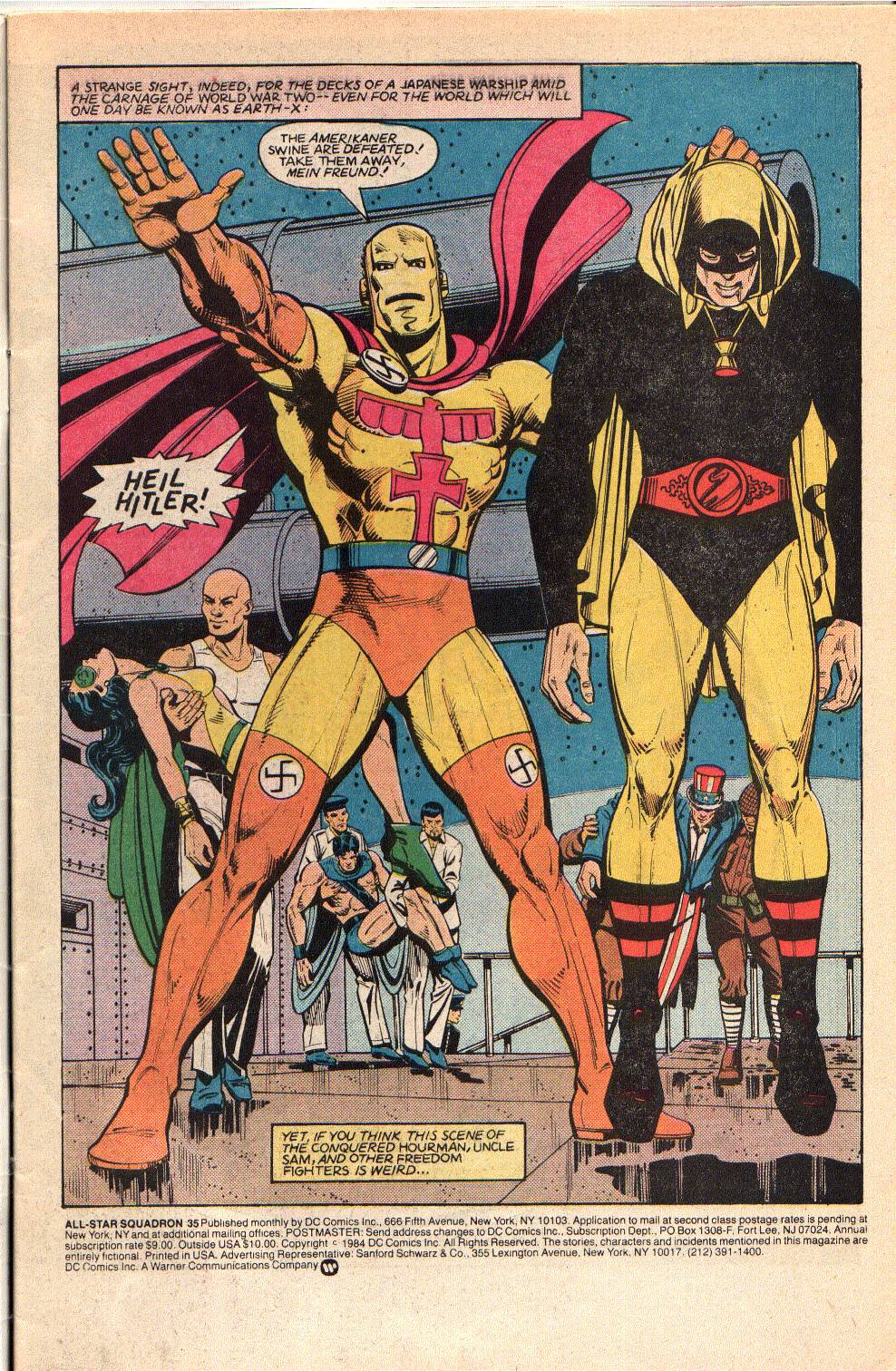 Come on ref; are you blind? Hourman was pearl harbored and that Japanese sailor is checking out Phantom Lady's cleavage! Hourman's title belt is a bit lacking in detail.  Meanwhile, Spector is busy trying to keep the two parallel worlds from colliding, while we see Tsunami "waving" at Liberty Belle and Johnny Quick. But first some appropriate music for waves rolling over people.... Dick Dale and Stevie Ray Vaughn-The world can barely contain such guitar awesomeness! Back at the ranch.....Starman interrupts Tsunami by placing a cosmic energy shield around Libby & Johnny and she swims away. Firebrand offers a lift and Johnny continues to change his name to Richard, as he mouths off and flies away. Brandy gives Libby the lift. 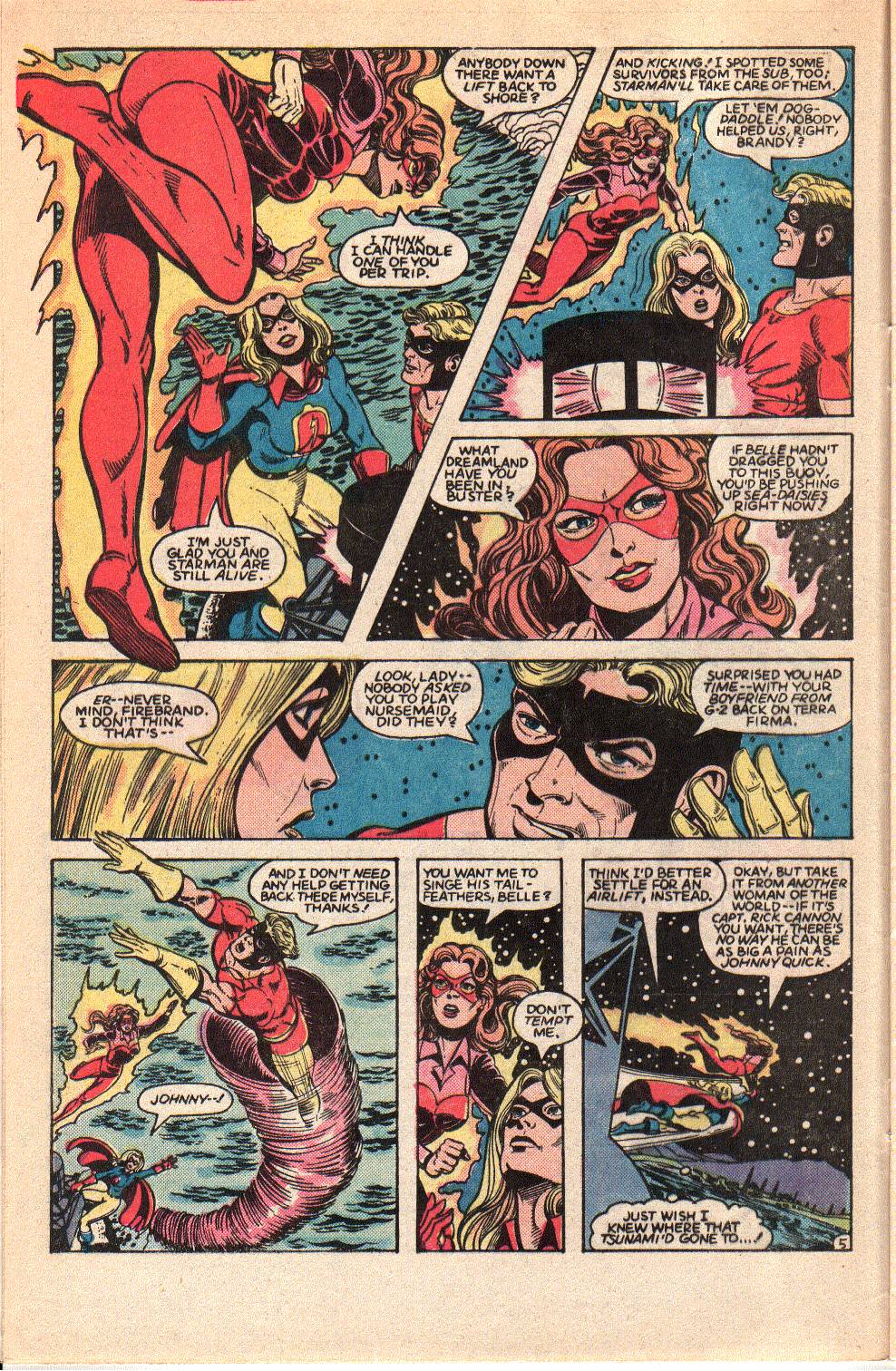 Tsunami tries again, but is interrupted by Neptune Perkins, though she can breathe underwater and Perky has more in common with a dolphin. Brandy gets Libby to shore, where she meets up with Rick, her beau, but blows him off. Apparently she likes her men insecure, as she looks to the sky for Johnny. 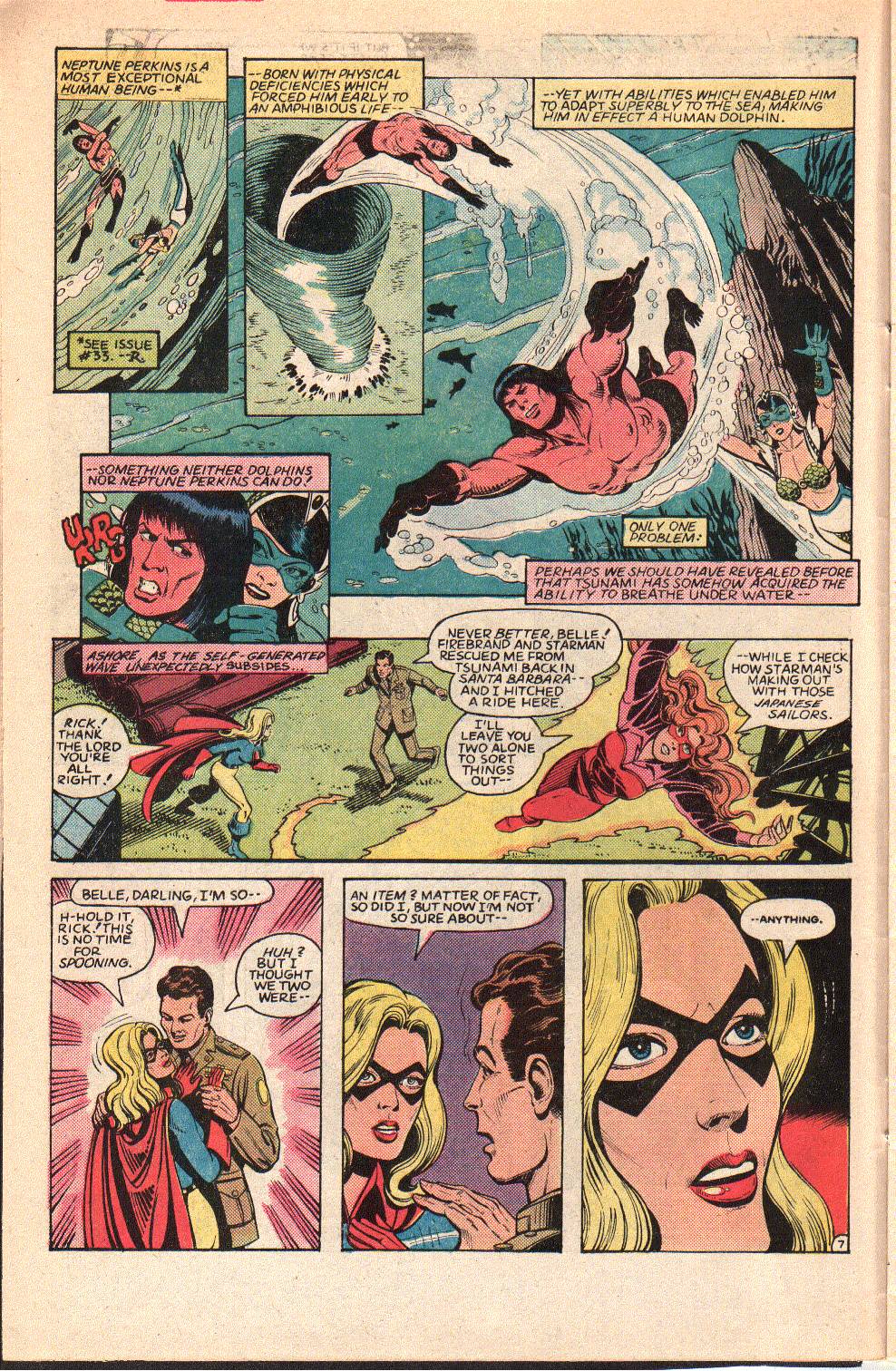 Instead, what she sees are lights in the sky, as the disruption of the merging parallel worlds is made manifest. Spectre is up a creek and I think it is brown. Meanwhile, Baron Blitzkrieg has the Freedom Fighters chained up at ringside and even Hourman is locked in place, so no fair fight here. Fire the ref! Somebody send Lou Thesz in there! BB crows for a bit and reveals a rather dubious set of events that led him to cross over to Earth-X, as he "sensed" Uncle Sam's crossing and "mustered his own energies" to tap into the field and cross. I guess Roy gave up on trying to come up with something clever. 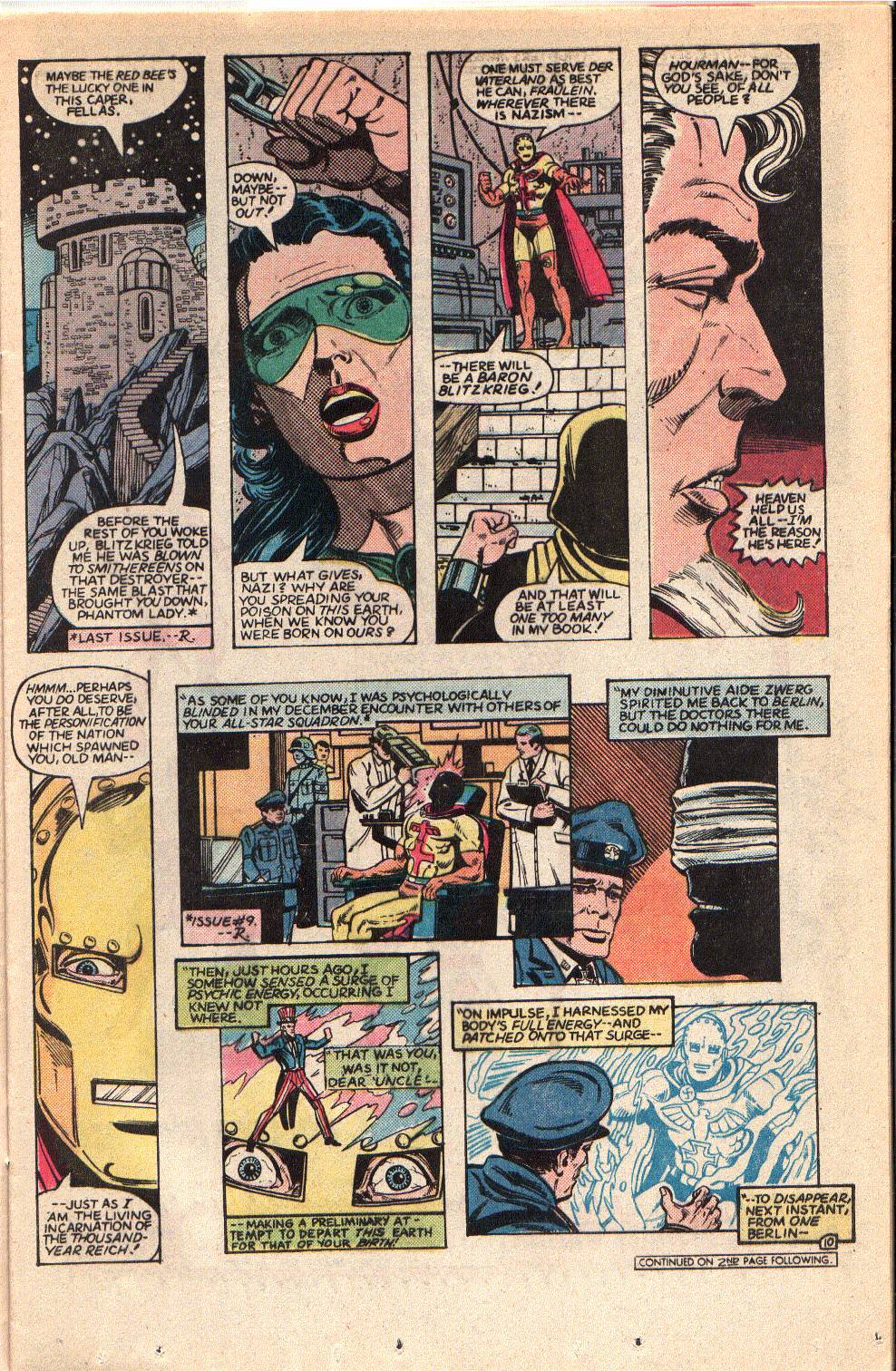 BB's sight was restored and he learned of Mid-Nite and Doll Man, from interrogations of the Maquis. He further learned of Hourman being held by the Japanese and muscled in on them. They seek the secret of Miraclo. Hourman replies that it only works on his metabolism an BB reveals that Hourman is a junkie. He plans to force the answer by torturing the others, starting with PL. Hourman mentioned Black Light being a potential catalyst for a Miraclo ray, which BB recalls PL's projector, right after she thought about it. Before he can do anything, the Red Bee turns up and hits him with Hacksaw Jim Duggan's 2x4. BB isn't phased much and he responds by beating the nectar out of Red Bee. While he is distracted, the Ray fires a beam at Phantom Lady's black light projector. It then bathes Hourman in black light... 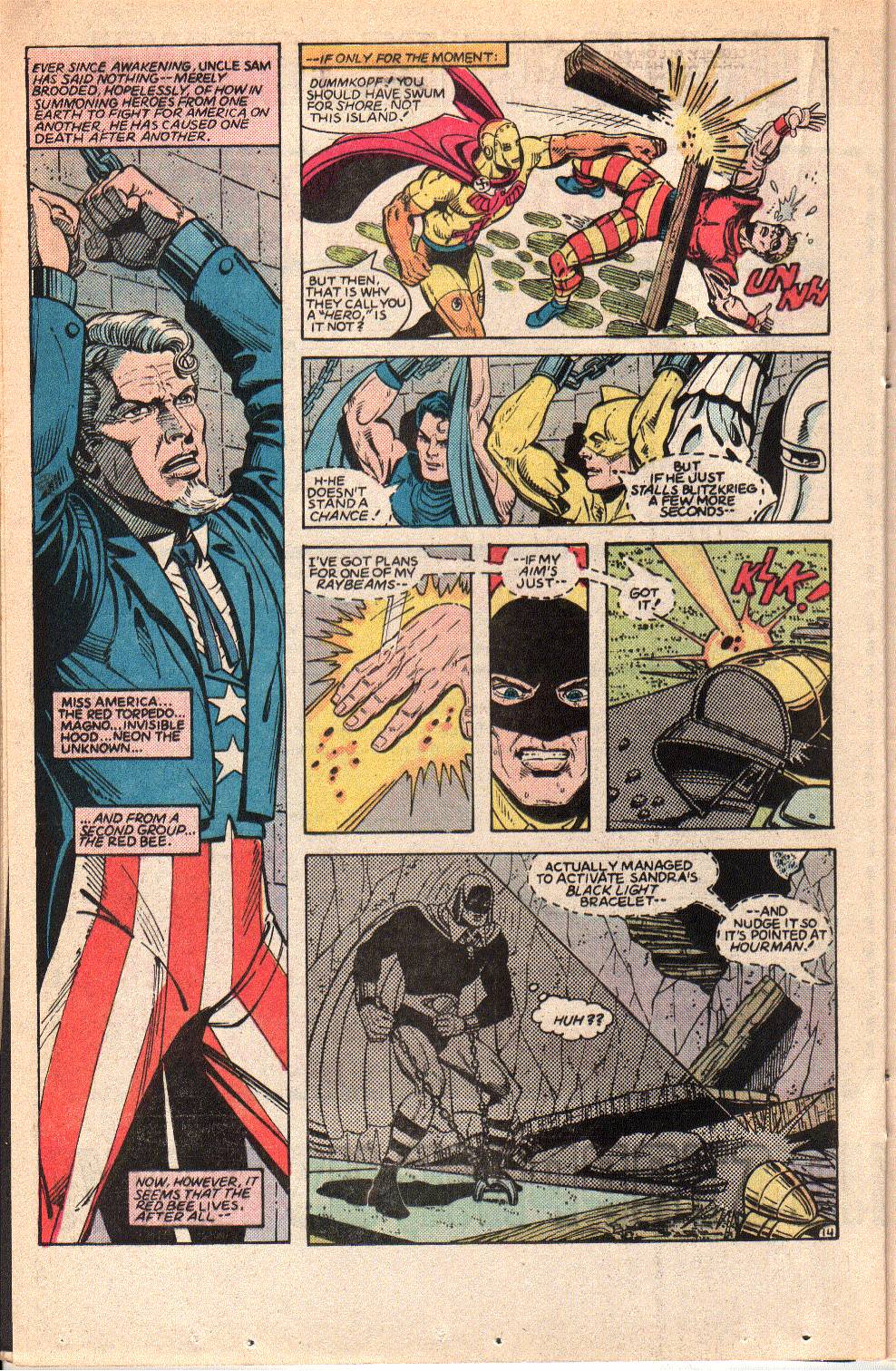 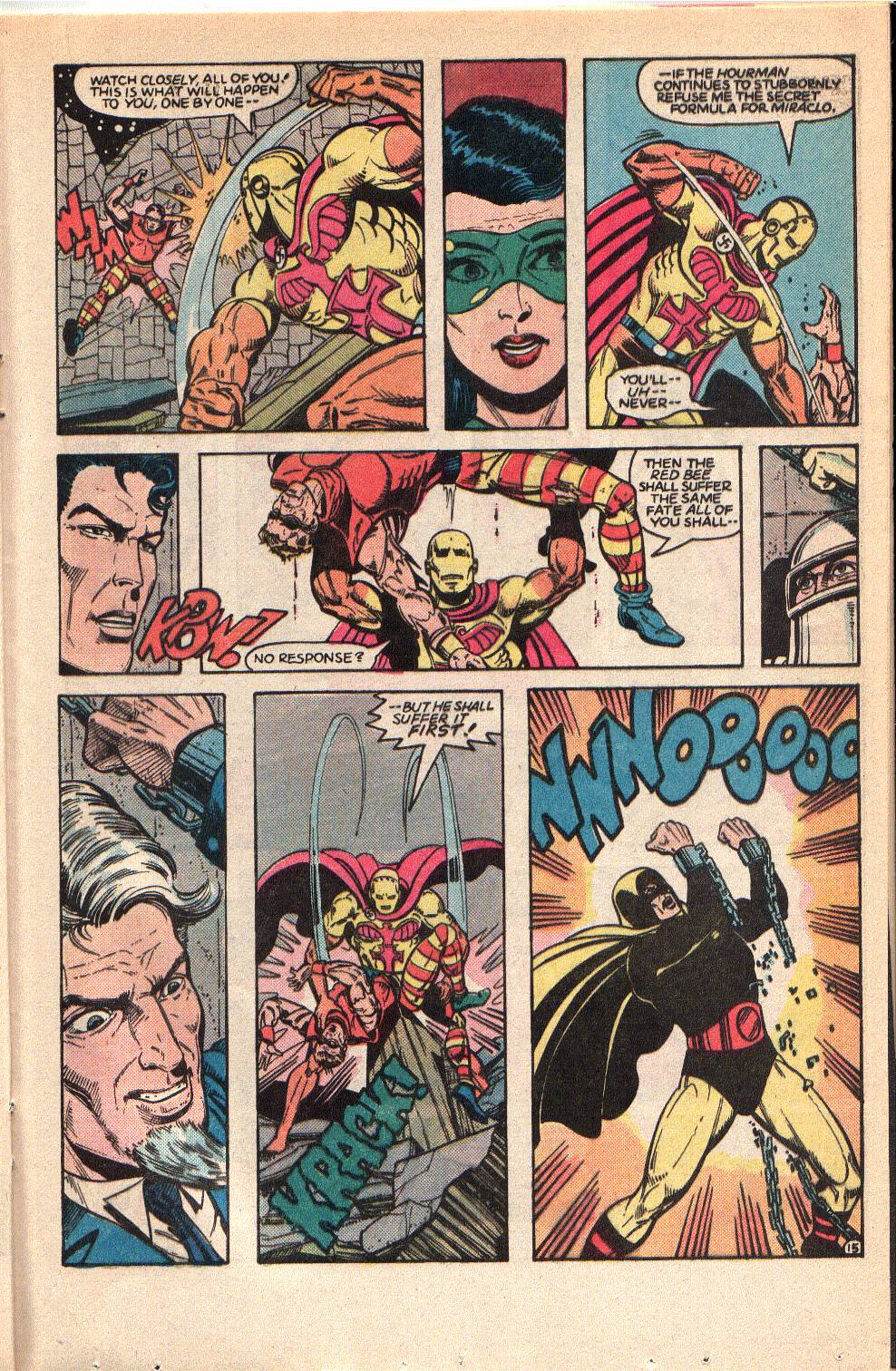 Faster than you can say "Superman comeback," Hourman is on BB like politicians on money thrown tot he ground! He batters BB, but he doesn't have enough Miraclo in his system. No matter, as Uncle Sam is getting POd. There is nothing meaner than a cranky spirit of freedom and Sam hates orange, yellow and magenta Nazis!  More goons turn up, giving the Freedom Fighters something to do. The red lights then appear in the sky. BB feels the energy and buggers off with 3 Earth-X Nazis. Spectre tells Sam and the gang that 3 have to stay to provide balance, but everyone else has to go to Earth-2. Uncle Sam, The Ray and Black Condor stay, while Hourman, Phantom Lady, Human Bomb and Doll Man head home, vowing to return. Sam puts on his hat and the three get ready to take the fight to the Axis. On Earth-2, Tsunami swims away and BB and his goons turn up in Santa Barbara, where he is blind again. He freaks and the goosesteppers disappear in white light. The reinforcements arrive and Johnny sees Capt Rick Cannon. He has simmered down and is about to act like an adult, when Libby whispers to Rick and then lets Johnny know how dear he is... 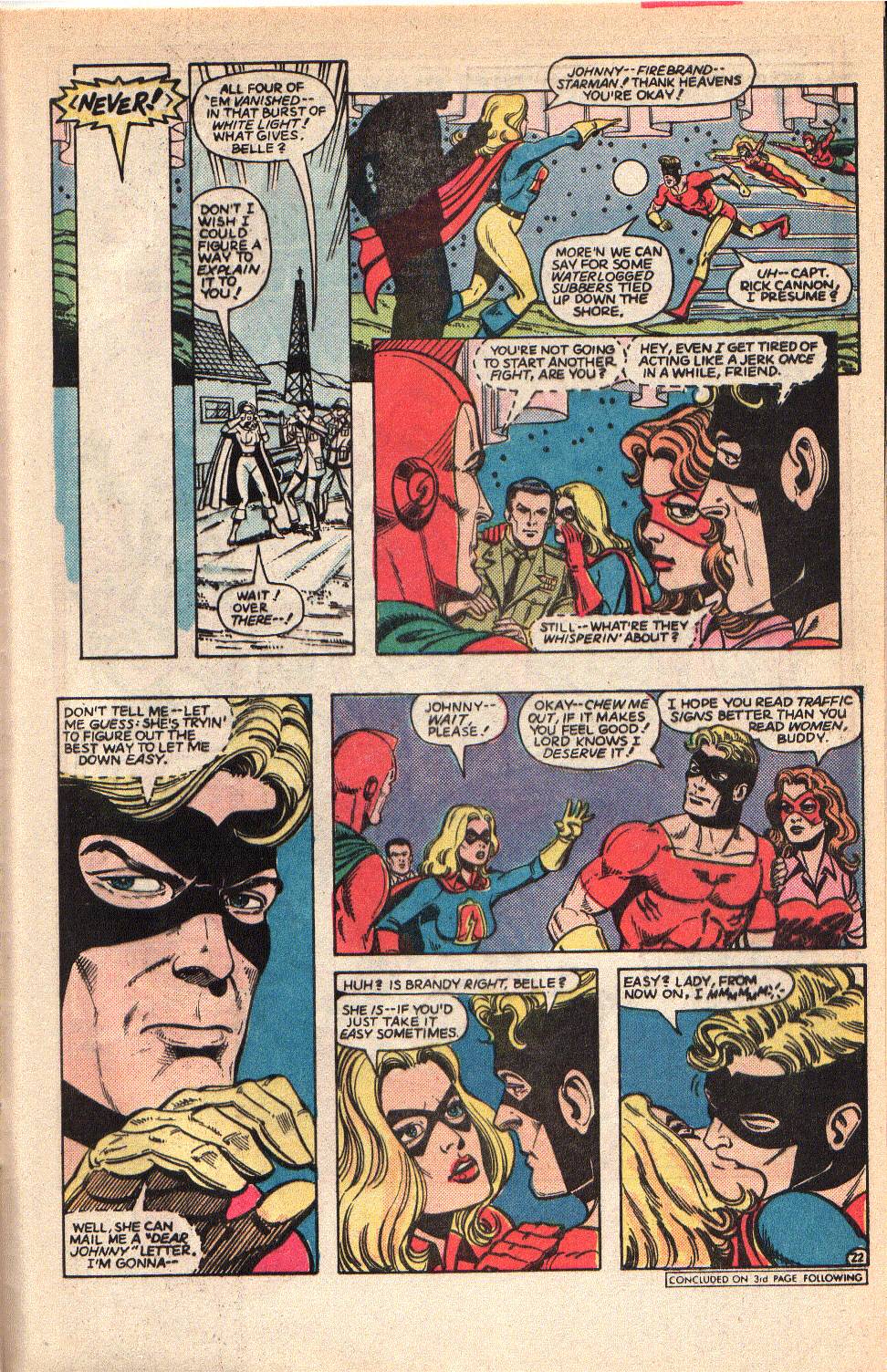 The Earth-X contingent arrives and we head off, as the Spectre eulogizes The Red Bee. 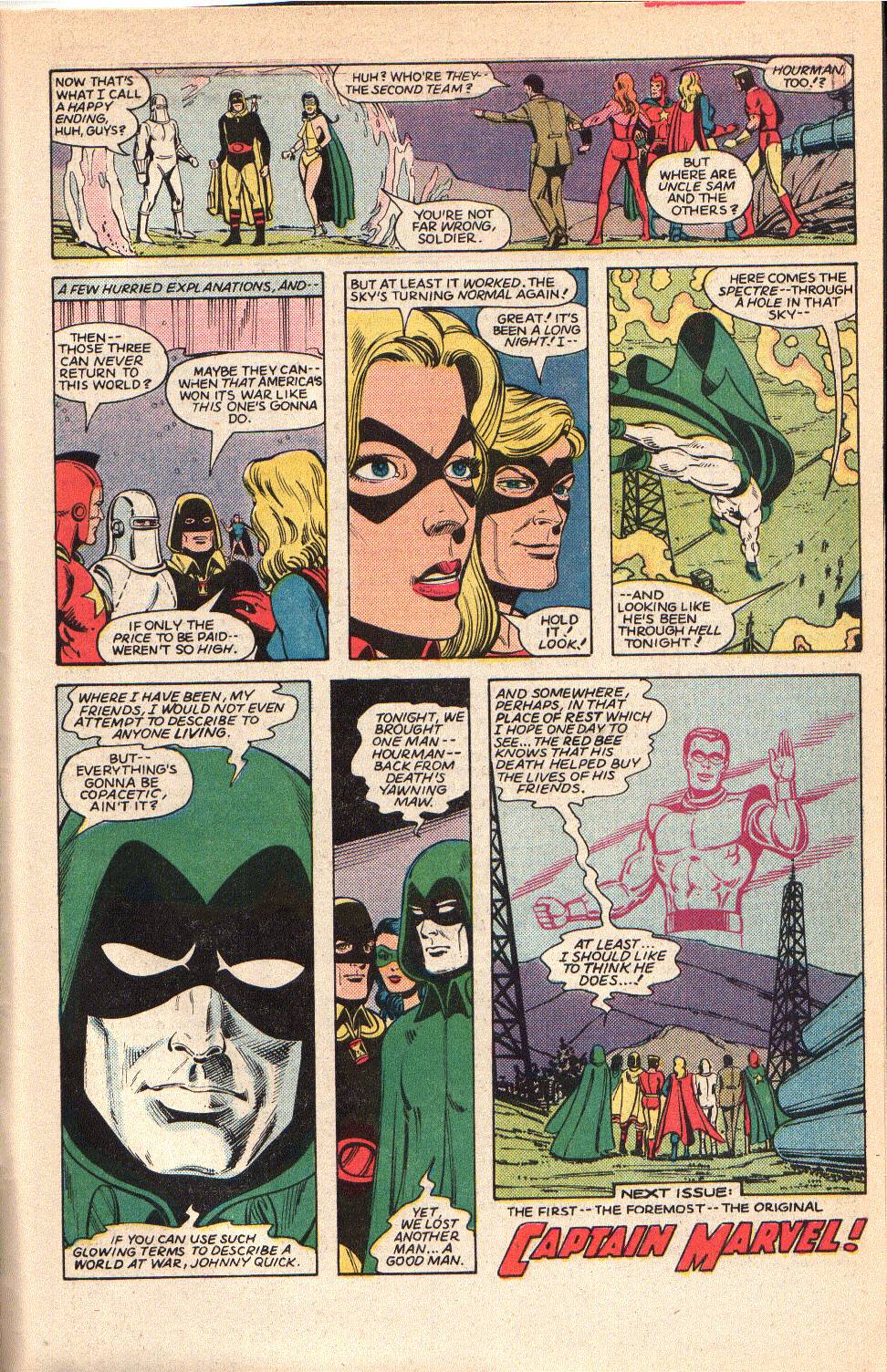 Thoughts: Thoughts: Decent ending; but, the split Earth storyline kind of leaves both halves weaker, to me. The Earth-X part was far stronger and I think this might have been better served to have been an annual, setting up the Freedom Fighters and other Quality heroes on Earth-X, or a mini-series. As it is, we are left with half there and half on Earth-2, giving Roy an excuse to explain how they got there. It will be a moot point, in about a year. James Robinson would revisit the Red Bee when David and Jack Knight had one of their annual reunions and have dinner with departed heroes, including Zatara, Dr Mid-Nite, Hourman, Mr Terrific, Atom, Red Bee and the GA Black Canary (who Jack knows had an affair with his father). Bee acts like a tool; but, Robinson lets him have some closure, allowing him to finally rest. Next up is our third annual issue, which is going to have quite a few artistic contributions, including the original Green Lantern artist, Martin Nodell! Historical Notes: Nothing of any real consequence in the story. July 1942- The Holocaust continues. In the Netherlands, Westerbork transit camp begins transporting Jews to the death camps. The Warsaw Ghetto begins the deportation of Jews to the camps. This will ultimately touch off the Warsaw Ghetto Uprising. They are brought to Treblinka, where they are gassed in the newly built gas chambers, using Zyklon-B, originally develiped as a pesticide. In France, on July 14, Bastille Day, Gaulists stage demonstrations against the Vichy government. Members of the fascist French Popular Party shoot and kill 2 women. On July 16, the Vichy government, under Pierre Laval, orders the police to round up Jews and somewhere between 13,000 and 20,000 are imprisoned. Convoy PQ17 breaks up to avoid the German battleship Tirpitz, resulting in the sinking of 24 ships by land based bombers, after the merchant ships were left without military escorts. Only 11 of the original 35 ships would make it to port and Allied-Soviet relations suffered badly, as Stalin did not believe the Germans could destroy so many ships. Convoy acytions were suspended until September and tactics revised. The incident would inspire the novel HMS Ulyssey, by Alistair MacLean, who served on convoy duty in the North Atlantic. On the plus side, the German navy withdrew their U-Boats from their positions off the US Atlantic coast due to the effectiveness of their convoy operations. The Oxford Committee for Famine Relief, better known as OXFAM, was founded on July 31. In North Africa, the British and Commonwealth forces fight the First Battle of El Alamein, against Rommel and the Italians. After defeat at the Battle of Gazala, in Libya, the British Eighth Army retreated east to Egypt, with plans to set up a defensive line at Mersa Metruh. The defending force was made up largely of Indian Army , ANZACS and South African troops. The British did not have enough armored units to defend at the border and it was felt that Mersa Metruh would be a better spot to defend against Rommel's advance. The forces were arrayed along an area that had minefields set up, with strong points in between, which troops manned with artillery and armored support ready to be brought up. In truth, there were not enough armor assets to hold the position and it was intended as a delaying tactic to give time to strengthen defenses at El Alamein. The Germans broke through the minefields and poor coordination of forward units meant that the defense largely collapsed. At one point, the New Zealanders were cut off, but were able to break through the lines, with little loss of life and retreat to the East. A second defensive pocket was set up at Fuka, with similar results. At El Alamein, the defenses were far stronger, with flanks better defended and Rommel would have to cross the Sahara to sweep around the defensive line. Rommel had severe problems with logistics and lacked supplies and transport for what supplies he had, and fuel, water and ammunition were in constant short supply. The British had broken Italian naval codes and the German ULTRA codes and were intercepting supply convoys in the Mediterranean, though Rommel was oblivious to this and blamed the Italian government and Navy, while praising its soldiers. Rommel planned to break through the line and split his forces in two, one end circling north to the coast road to cut off the defenders there and the other to circle to the south and isolate that group. The operation didn't go as planned. Rommel met a stiff defense and the British units employed heavy amounts of artillery to hit Rommel's tanks, matched with infantry to face his panzer grenadiers. Massive bombardment broke the inexperienced troops of the Italian 60th Infantry Division and the Australians took over 1500 prisoners. The Germans brought in more Italian troops and armor and things settled down into a state of attack and counter-attack. The battle raged from July 1-27 and mostly ended in stalemate, but succeeded in halting Rommel's advance, while he worked to build up his supplies. The British worked on reinforcing their supplies and assets after the Germans pulled back. Afterward, Churchill stopped in Cairo, en route to Moscow (for a meeting with Stalin) and decided to relieve Gen Auchinleck and place Gen William Gott in command of the Eighth Army. Gott was killed in a plane crash and a junior general, Bernard Law Montgomery was placed in command, in his stead. In the Pacific, the Japanese, having their seaborne invasion of Port Moresby blocked by losses in the Battle of the Coral Sea, decided to try a land advance over the Kokoda Trail. They landed troops near Gona and Buna, on the Northern end of Papua New Guinea and planned to move the troops through the Owen Stanley Range, via mountain paths. Gen MacArthur ordered Australian forces forward, with little regard for the terrain and unrealistic expectations of how fast they could move. The Australians lacked modern equipment and were unable to bring artillery or heavy machine guns along, as they were stuck with heavy Vickers machine guns. They did not have proper air logistics support, either, to resupply via airdrop, as in Burma, later in the war. The Aussies had to carry their supplies and weapons into the jungles and mountains. The Australians and Papua natives took heavy casualties and the Japanese executed prisoners captured. The Australians responded by not taking prisoners, themselves. Accusations of cannibalism were also levelled against the Japanese and post-war triels under Australian military courts led to executions, though no charges were brought under Al;lied trials, in Tokyo, due to "lack of evidence." The Japanese forces were reinforced from Rabaul and the Aussies were eventually reinforced with the US 32nd Division, who deployed the 126th and 128th Infantry Regiments to Port Moresby. US forces were unprepared for jungle and mountainous fighting and were very slow to advance. The Japanese withdrew at speed and eventually abandoned the operation to take Port Moresby, as it had pressing problems that will be described next time. By January, the area was back in Allied hands, but not without massive problems. 3 Australian generals were sacked, though many historians have pointed fingers at MacArthur's leadership as being the center of the problem. It is believed that MacArthur used the Australians as scapegoats for his own bad decisions, as his reputation had already suffered badly in the Philippines. MacArthur was one of the earliest users of the news media to promote his own image, which was reflected at Bataan by the images of a heroic stand in the US, while troops were calling him "Dugout Doug," because he and his staff rarely emerged from their underground HQ. MacArthur was afraid of being second fiddle to Nimitz's plans for advancing through the central Pacific and pushed for results in New Guinea that were idealistic, at best. Later, he would push for landings at Pelileu, to provide a strategic place for an airfield, to support the invasion of the Philippines. The Marines suffered heavily in the battles to take the island and it was never used to support MacArthur's invasion forces. The Kokoda Trail was the Australian Army's first test at defending their homeland, after being used as colonial muscle for the British Army, in the Middle Eastern Campaign of WW1 and North Africa, in WW2. It would lead to a major reorganization of the Australian Army and their focus on equipment and training, leading to a greater emphasis on jungle fighting and the terrain of their neighboring islands, as well as how they operated and coordinated units. These doctrines have carried on into the modern Australian Army, including deployments to Vietnam, where they proved to be very effective, as well as Aussie operations in East Timor. Meanwhile, on July 3, a Japanese naval construction force landed on the Island of Guadalcanal, in the Solomon Island chain, which was occupied only by natives, who were quickly conquered, with little resistance. They began establishing an airfield there to support the strategy of isolating Australia from the Allies, thereby removing it as a base to move against Japanese holdings, while the Japanese fortified their areas. The Japanese defensive strategy was to create a system of island fortresses which could provide land-based air power to attack naval forces, thereby preventing any attacks on Japan, while they exploited the mineral and agricultural resources of conquered territory. The Allies learned of the construction on Guadalcanal. They had already targeted the Solomon's for the first offensive operations in the Pacific, to help protect the sea lines of communication to Australia. The three targets designated were Tulagi, Florida Island and Guadalcanal. Originally, Tulagi was chosen because it had a large natural harbor and would be an ideal base for floatplane patrols. Florida Island dominated the approach to the harbor at Tulagi, leading to its designation. Guadacanal was a hasty addition, after learning that the Japanese were constructing an airfield there. In May, the 1st Marine Division, under Maj Gen. Alexander Vandegrift, was ordered to New Zealand, to prepare for offensive operations in the Pacific. Among those Marines assembled, were PFC Robert Leckie, Sgt John Basilone, and Lt Col Lewis "Chesty" Puller. We will meet those men next time, as America finds new heroes, in the real world.
|
|
zilch
Full Member
Posts: 244 
|
Post by zilch on Aug 23, 2020 18:52:14 GMT -5
Great work!!!
I'm just kinda browsing through, since i did a lot of this stora research when i was compiling my original Earth-2 timeline back when the series was coming out (nearly 40 friggin' years ago!). That morphed into my DC Universe timeline after Crisis. Which i wrote on WordStar at work.
Keep up the (exausting!) great stuff!
-z
|
|
|
|
Post by mikelmidnight on Aug 24, 2020 11:50:12 GMT -5
I'm just kinda browsing through, since i did a lot of this stora research when i was compiling my original Earth-2 timeline back when the series was coming out (nearly 40 friggin' years ago!). That morphed into my DC Universe timeline after Crisis. Which i wrote on WordStar at work.
This put me in a quandary because I had my own website which obsessively timelined both Earth-2 and Earth-X (among others), and I refused to recognize it as canon. I don't recall how I dealt with it (I suspect I assumed (a) the Quality heroes on Earth-2 were too trivial to mention aside from James Robinson's Spider and (b) my timeline referred to the QUALITY COMICS Earth and not the one shown here).
|
|
|
|
Post by codystarbuck on Aug 24, 2020 23:11:25 GMT -5
I'm not that obsessive (well, not in that area); but, I much preferred the idea that the Quality Heroes were born, raised and became superheroes on Earth-X, with no input from anywhere else. It's part of why I preferred the parallel Earths to the post-Crisis fusion. To me, these characters usually worked better in their own contained environment. It was not that hard to keep track: Earth-1-modern DC heroes of the Justice League; Earth-2-Golden Age heroes of the JSA and related colleagues, Earth-3-world of supercriminal analogues to the JLA, with no heroes to stop them (until Alexander Luthor), Earth-X-Quality Comics Heroes, Earth-S-Fawcett Comics Heroes (mainly the Marvel Family) and Earth-4 was introduced for the Charlton Action Heroes. Earth 4 wasn't necessary, as you could have introduced the characters as new heroes, on Earth-1, had DC chosen to do so, rather than debut them in Crisis. I also preferred the idea that the war characters existed in a separate world, though that went south when Sgt Rock met Batman. I don't count Earth-B, as that was just a joke term for the humor titles that DC published over the years, as was Earth Haney, to explain why Haney ignored continuity in his Brave & the Bold stories. Earth-A was a fairly lame story and that world was ignored until Gerry Conway decided (on his own or at editorial urging) brought back their Johnny Thunder to mess up Black Canary's history, which became moot in a couple of years, anyway. Earth Prime as our world was fine, until they gave it a superhero.
The bulk of the parallel world stories were Earth-1 and 2, with Earth-S rarely crossing over, since it was more light-hearted in tone through its existence). Earth-X was ignored after the original crossover, aprt from the first issue of The Freedom Fighters, when they cross over to Earth-1, chasing the Silver Ghost and end up framed. The rest of their stories were on Earth-1. I'd have much rather seen their battles with the Nazis, in an alternate world where they controlled the planet and there is a global underground resistance, with people like the Freedom Fighters and the Blackhawks taking the fight to them. It was the integration of Blackhawk and Plastic Man with the regular DC line, rather than stating they were on parallel worlds, that threw a monkey wrench into the Quality Comics handling.
It always amazed me that so little was done with the Freedom Fighters, after their series ended; or, even before, given that it was nearly 2 years after their debut in JLA, before they were used. About the only post-Implosion use I can recall is DC Comics Presents #62, 5 years after their series ended. The Ray got one lone back-up story in Black Lightning, before the implosion killed that (and most of those advertised back-up features), and Phantom Lady got an appearance in Wonder Woman #292, which was the middle part of a three chapter storyline, teaming up Wonder Woman with the other heroines of DC Comics (minus Mary Marvel and the Legion ladies).
I get that Roy wanted to use some of them; but, why not just make them Earth-2 versions, as with Plastic Man? Plas and the Blackhawks are mentioned in JLA 107-108, though both were integrated into the DC line, earlier and are mentioned as dead in the crossover storyline.
Mostly, I just want my Freedom Fighters maxi-series, with them battling Nazis on a world where its just them and other Quality characters. It is too good a concept not to explore; but, it never really has, beyond that JLA two-parter.
|
|



